YOU ARE WHAT YOU READ
Dig into the 10th year of the Unbound Book Festival. PAGE 18


COLUMBIA’S MIX MASTER PAGE 11 STORYBOOK SURREALISM PAGE 13 HOOPS AND DETERMINATION PAGE 24
PUFF (PASTRY) PIECES PAGE 31



Dig into the 10th year of the Unbound Book Festival. PAGE 18


COLUMBIA’S MIX MASTER PAGE 11 STORYBOOK SURREALISM PAGE 13 HOOPS AND DETERMINATION PAGE 24
PUFF (PASTRY) PIECES PAGE 31


Idon’t remember much from middle school, but a memory that has stuck with me is my guidance counselor saying the meaning of life is “choice.” It seemed simple at the time — if life is one giant tree, then we pick choices like fruit off the branches, like in Sylvia Plath’s The Bell Jar. Then again, Plath also imagined that unchosen choices would eventually rot and fall off.
The definition and reality of choice is becoming foggier to me these days. I try to choose staying true to myself and pursuing what I value, but what if the freedom of choice is an illusion?
I graduate from college in a few months, and people tell me the world is my oyster, but in reality, the job market will decide my future for me. And while I have bodily autonomy, people in power are still trying to put regulations on how much control I get.
Whenever I burrow into my head like this, I think of my mother. She was diagnosed with optic nerve atrophy when she was in high school but didn’t start noticing the effects until college. Due to her declining vision, it took her 15 years to get her doctorate and become a professor. But, because she was so passionate about learning and helping others, she found a way to complete her degree and taught social
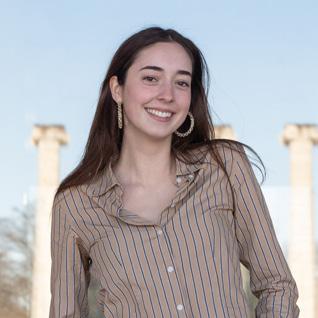

Photography by Valerie Tiscareno
work for two decades.
For others, choosing to stay true to yourself manifests in different ways.
Davis Taylor’s heart belonged to sports (p. 24), but he couldn’t compete like he used to after an ATV accident. Through hard work and adaptability, he learned how to play wheelchair basketball and was selected to play on the 2025 U.S. Men’s Under 23 Team. This month, he travels to Bogotá, Colombia, to play against other wheelchair basketball teams around the Americas.
The surrealist classical paintings of Zoe Hawk (p. 13) exhibit the idea of girlhood as a performance. Several of her paintings feature young women in 1950s housewife garb lounging or playing in groups, metaphors for the transition into adulthood. She says she couldn’t fathom not telling stories with her art.
I may have been having an existential crisis about my future at the beginning of this letter, but these stories show that choice is not a fantasy — just a complex relationship between desire and reality. In Aristotle’s ethics, he defined choice as “deliberate desire.” And I still may be just a young adult, but it is clear in this issue of Vox that your true passion, if you stick with it, will get you far.

OLIVIA MAILLET Editor-in-Chief
The concept for the design of this issue’s Unbound feature (p. 18) started with a funny phrase from my childhood. My parents used to tease me about eating so many chicken nuggets that I’d eventually turn into one. They would always say, “You are what you eat!” In the same way that food provides nourishment for our bodies, books provide nourishment for our brains. We might not consume literature in the same way we consume a cheeseburger, but it makes up who we are all the same. Thus, the concept was born: “You are what you read.” I thought a funny and interesting way to portray this idea visually was to imagine books to be edible and served up in a restaurant.
The Vox visuals team gathered books from previous Unbound keynote speakers and various kitchenware to make this studio shoot happen. — Lauren Green
EDITOR-IN-CHIEF OLIVIA MAILLET
MANAGING EDITORS GRACE BURWELL, CAYLI YANAGIDA
DEPUTY EDITOR ABIGAIL RAMIREZ
DIGITAL MANAGING EDITOR MJ MONTGOMERY
AUDIENCE ENGAGEMENT EDITOR ALEX XU
ART DIRECTORS VALERIE TISCARENO, LAUREN GREEN
PHOTO DIRECTOR ASHLEE KLOTZBUECHER
MULTIMEDIA EDITOR KATE RAMSEYER
SENIOR DIGITAL PRODUCER SARAH GASSEL
ASSISTANT PHOTO EDITOR EMMA RAE GERWEN
CONTENT STRATEGIST KALYN LAIRE
ASSOCIATE EDITORS LEVI CASE, HAVEN DAGER, KIANA FERNANDES, SARAH GOODSON, NAOMI
M. KLEIN, DINA MURRAY, AVERI NORRIS, AVA ORR, ASHLYNN PEREZ, NATALIE-ELIZABETH TAN, YINAN WU
STAFF WRITERS MERCY AUSTIN, ALEX DAGGETT, AUSTIN GARZA, KATIE GRAWITCH, SYD MINOR, ALLY SCHNIEPP, EMMA ZAWACKI, SOPHIE AYERS, ALLI BEALMER, LAURYN RHODES, NEALY SIMMS, RAPHAEL STERNADORI, TYLER WHITE
DESIGNER SYD MINOR
SOCIAL & AUDIENCE ZOE SALEEM, CLAIRE WILLIAMS
DIGITAL PRODUCERS CHARLIE DAHLGREN, ABIGAIL LANDWEHR, CHARLIE WARNER
DESIGN ASSISTANTS LILY CARROLL, RACHEL GOODBEE, SOPHIA LINDBERG
CONTRIBUTING WRITERS BRIANNA DAVIS, MAYA DAWSON, AUDREY ELLIS, JASMINE JACKSON, SOPHIA KOCH, OLIVIA MAHL, DAVIS WILSON
CONTRIBUTING PRODUCERS JARED ARCHER, ARABELLA COSGROVE, ETHAN DAVIS
EDITORIAL DIRECTOR HEATHER ISHERWOOD
DIGITAL DIRECTOR LAURA HECK
WRITING COACHES CARY LITTLEJOHN, JENNIFER ROWE

WANT TO BE IN-THE-KNOW?
Sign up to receive Vox ’s weekly newsletter, the “Vox Insider.” We’ll tell you how to fill up your weekend social calendar and keep ahead of the trends. Sign up at voxmagazine.com.

CALENDAR send to vox@missouri.edu or submit via online form at voxmagazine.com
ADVERTISING 882-5714 | CIRCULATION 882-5700 | EDITORIAL 884-6432
APRIL 2025
VOLUME 27, ISSUE 3
PUBLISHED BY THE COLUMBIA MISSOURIAN LEE HILLS HALL, COLUMBIA MO 65211
Cover design: Lauren Green
Cover photography: Ava Kitzi
Cover photo illustration: Valerie Tiscareno
Los Comales is like home
Vox reporter Austin Garza reconnects with his Mexican identity and community.
Love houseplants?
This guide to growing native Missouri plants on your patio is for you! 10
Vox Picks
From blooms to bluegrass, Vox has you covered with can’t--miss picks for April.
Producing to his own beat
Wil Reeves uses his studio to help local musicians find their voices.
Girlhood gallery
Growing up can be surreal, but Zoe Hawk paints the perfect pictures.
Quick lit just clicks
Celebrate flash fiction literary journal Wigleaf’s 17th anniversary. 17
‘Why would I ever leave?’
Up-and-coming artist Chloe Hoecker joins the Midwest Princess ranks.





You are what you read
Keynote speaker Min Jin Lee, author of Pachinko, and other panelists will spark boundless thought during the 10th Unbound Book Festival.
Davis Taylor takes the court to represent the 2025 U.S.A. Men’s Under 23 wheelchair basketball team.
A batch made in heaven Alexis Candia’s sweet treats shine at Ozark Mountain Biscuit Co.
Cajun on wheels
Get a taste of New Orleans at Das Byrd’s Nest as it flies around Columbia.
Three nature photographers bring awareness to native fauna one photo at a time.

Seven-month-old Sebastian

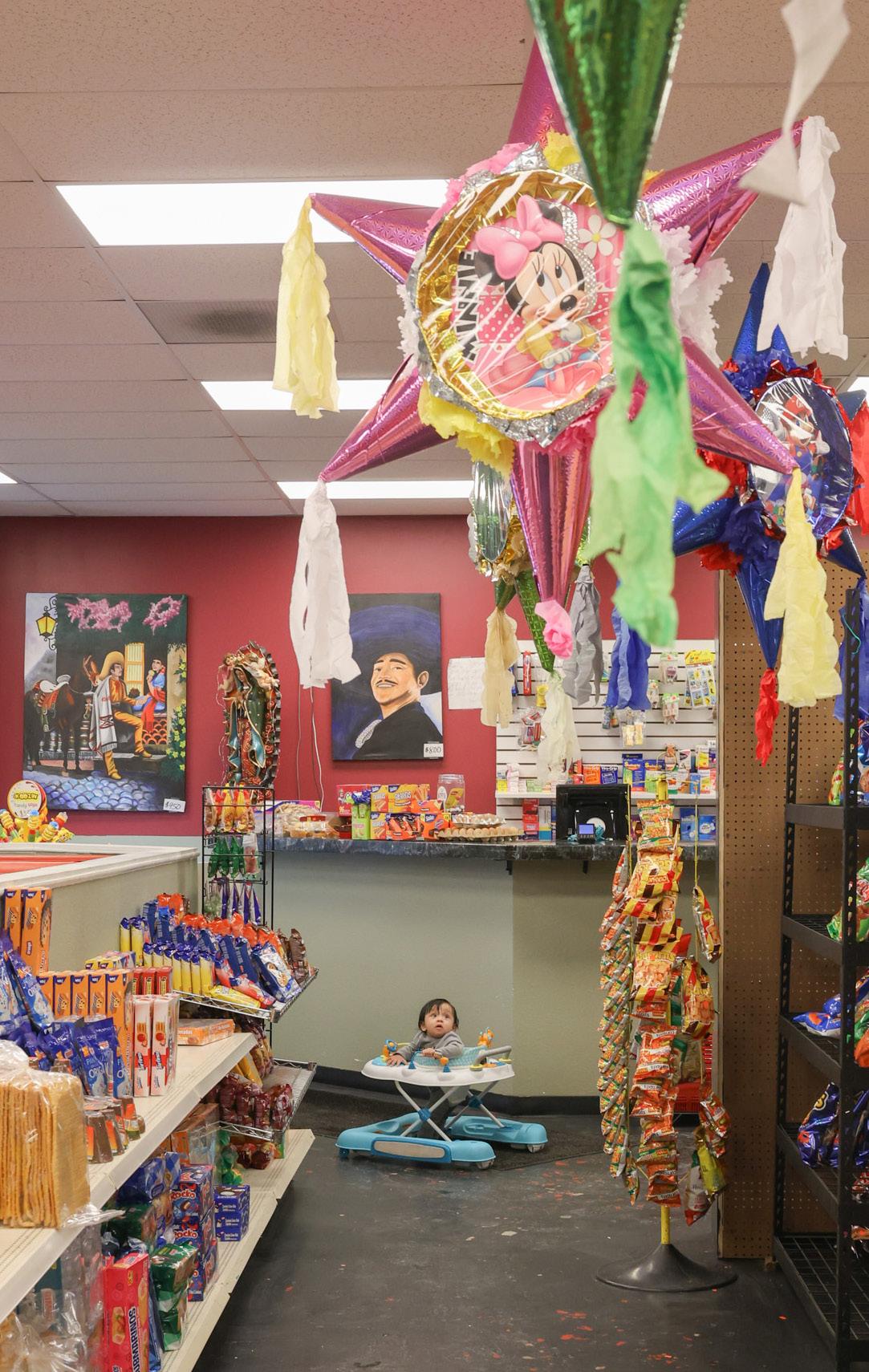

Local Mexican restaurant and store brings food, culture and resources to the community and Columbia’s Latino population.
BY AUSTIN GARZA
I grew up a “no sabo kid” — someone with a Latino background but little Spanish speaking ability. The phrase incorrectly conjugates the verb “saber,” meaning “to know,” and it subtly pokes fun at people who “know” the culture, but don’t really know . Growing up, when I would tell people I’m Mexican, it would often be met with a confused look followed by, “Really?” or “Don’t lie.” It was something I felt proud telling people, but the perplexed responses made me feel like I wasn’t Mexican enough — and that hurt.
Spanish courses, family gatherings and the many times my dad watched Selena on TV gave me some exposure to Mexican culture, but it kept me at arm’s length from diving deeper into my heritage. I spent much of my life disconnected from this thing I always wanted: a strong cultural identity. I wanted to speak Spanish and eat Mexican food beyond the Tex-Mex I was accustomed to. For as long as I can remember, I was dying for anything to bridge the gap separating my heritage and me.
So, when I heard about a Mexican restaurant tucked away on I-70 Drive Southeast, I was more than interested. I felt an opportunity to step out of my bubble as I saw a chance to experience exactly what I wanted: a deeper connec-
tion to my heritage. As I walked through the doors of Los Comales Restaurant and Store, the smiling staff, radiant red and orange walls and the sound of música norteña’s signature accordion playing on the TV immediately caught my attention, letting me know this was more than an ordinary dining experience.
Los Comales Restaurant and Store opened in 2022 and it offers a taste of Mexico with tangy yet savory al pastor tacos, tortas loaded with carne asada and menudo — a traditional soup consisting of pork trotter, tripa (cow intestine) and hominy (corn). The restaurant also sells produce, fresh meat and a myriad of cultural snacks and drinks.
Los Comales is the passion project of Ezequiel Mendez, a lifelong cook who emphasizes creating a close, familial atmosphere — one that is reflected in every dish served.
All in the family
Mendez came to Columbia from Morelos, Mexico, in 1998 and began cooking as a teenager. His cooking know-how came from time spent in the kitchen with his grandmother. Her recipes and
spice blends inspired about half of Los Comales’ menu, including the restaurant’s Seven Seas soup and chilaquiles. “I helped with her here and there,” Mendez says. “It was always fun. I enjoyed my time with her.”
The idea for the restaurant began 10 years ago after Mendez noticed how much people enjoyed his home cooking. But the finances were never right; instead, he worked in construction. Even after opening the restaurant, he didn’t quit his day job. Mendez begins work at job sites at 7 a.m. By early afternoon, you can often find him in the restaurant until close.
At Los Comales, family goes beyond the menu — it’s blended within Mendez’s relationships with the restaurant staff. He makes sure his employees are financially taken care of with fair wages and mentally supported with extra days off when needed. “It’s not like in business. It’s more like a friendship,” Mendez says.
Los Comales manager Alvaro Hernandez values his time at the hybrid eatery and its tight-knit environment. “I have worked here for two years,”
Get a taste of Los Comales at 3510 I-70 Drive S.E., 11 a.m. to 9 p.m.; 573-447-6243 or skip the line at orderloscomales mexicanrestaurant. com.
Hernandez says. “The people here are nice. This is a family; all people here are family.”
The eatery’s location in an obscure strip mall proved to be a roadblock for the first six months of business, but thanks to a solid base of returning customers, Los Comales started gaining momentum. Latisha Mendez, Ezequiel Mendez’s wife, credits the restaurant’s growing popularity to its customers’ word of mouth. The restaurant has become less transactional and more of a second home for many customers.
Customers can make international phone calls through its multiple landlines. Noel Eliezer (below) uses one to transfer money to his wife in Arkansas. Eliezer lives in Columbia, where he works in the restaurant industry.

Since it opened, Juan Laboy has dined at the restaurant three to four times a week. “My grandpa lives (both) in Puerto Rico and here,” Laboy says. “He wants to come here every day.”
The restaurant’s juicy, seasoned carne asada is one of Laboy’s favorite dishes. He also appreciates that he can order red snapper, a fish commonly used in Puerto Rican cuisine. This item might appear insignificant to the average customer, but this dish links mid-Missouri to cultural traditions.
Los Comales’ grocery store section features shelves lined with spices and sweet treats. Piñatas hang from the ceiling. The butcher counter offers a variety of fresh-cut meats, allowing customers to cook dishes at home.
“I get meat from over there and make my own carne asada,” Laboy says. “I get my chocolate milk here. It’s cheaper than the stores.”
The usual hustle and bustle fell silent on Feb. 3 when Los Comales participated in A Day Without Immigrants, a protest spotlighting immigrants’ contributions to the U.S. The silence spoke volumes as the empty restaurant stood in solidarity with the Latino community.
“I used to be an immigrant, too,” Mendez says. “To help everybody realize that we support this country, it’s not like how everyone says ‘expensive’ and ‘criminals’ and all that stuff. That’s not what it is.”
What I found at this Mexican emporium tucked away on an access road alongside I-70 was much more than a place to eat
by Nam Nguyen

food and go about my day afterward. Los Comales was an opportunity to connect with my heritage, which I welcomed with open arms.
On one visit, my girlfriend — who grew up in a Spanish speaking household — and I bought a handful of snacks, from the smooth sweetness of Duvalín to a salty chamoy-flavored candy. Although
I was not a fan of the latter, I gave it a shot, and that’s all that mattered. That night, she convinced me that a miniature shaker of lime-flavored salt was candy. She poured it on my hand, telling me to lick it off. Believing every word she said, I did exactly that and was met with a sour and salty attack on my taste buds. I didn’t know any better, but it was OK.

Ezequiel Mendez shares a rich Mexican culture with mid-Missouri through his hybrid store and restaurant.
I was finally learning.
Nobody said I had to stay a “no sabo adult.” In adulthood, I started embracing opportunities to participate in Mexican culture. I picked up Spanish again and will try almost any food I can get my hands on. I really enjoyed the meaty, savory flavor and the chewy yet crunchy texture of Los Comales’ tripa tacos. Explaining how I enjoy eating cow intestine led to a mix of interested and disgusted reactions from friends and family, but I loved it.
I bought ingredients to make my own frijoles charros, a dish consisting of pinto beans, chicharrones and a medley of pork. I had a great conversation with Laboy about our favorite dishes. The enthusiasm in his voice made me feel welcomed. The gap I felt my whole life was finally shrinking. Although my trip to Los Comales did not completely resolve my search for a cultural identity, these moments helped me realize it’s never too late to step outside your bubble, connect with your heritage and bring it all back home.


Find the perfect Missouri plant based on the personality of your fave houseplant.
BY KATIE GRAWITCH
Do you fiddle with fiddle leaf figs? Is your monstera monstrous? Do you have a nursery of spider plant babies? Consider localizing your love of houseplants with Missouri native species.
In addition to conserving water, feeding wildlife and pollinators and protecting soil from erosion, native plants are easy to grow and require little maintenance, according to the U.S. Department of Agriculture. They’re adaptable and can thrive in a variety of garden spaces, no matter how small.
To get started, consider your grow-
ing conditions. Different native plants will flourish in different settings, says Carol Davit, executive director of the Missouri Prairie Foundation and Grow Native! project. “Make note of how much sun your outdoor space gets,”
Davit says. “Is it a covered porch? Is it uncovered?”
When shopping for native plants, plant inspector Eze Pojmann-Ezeonyilo says to seek out nurseries that specialize in them so experts can help you build your ideal garden.
Austin Dixon, a private land conservationist with the Missouri Depart-
ment of Conservation, suggests selecting plants that bloom at different times of the year. Pollinators are typically active from April to October, he says. Having a wide variety of plants will attract pollinators all season long.
For container planting, the Missouri Prairie Foundation recommends using a soilless potting mix with fertilizer and a light layer of organic or inorganic mulch, such as bark or gravel.
Ready to start planting? Vox worked with Davit to create a guide to native plants that align with your houseplant preferences.
HOT TO POT
You can find native plants locally. Missouri Wildflowers Nursery, 9814 Pleasant Hill Road, Jefferson City, mowildflowers.net Missouri Prairie Foundation plant sale, 10 a.m. to 1 p.m. April 12, MU Bradford Research Farm, 4968 S. Rangeline Road. moprairie. org.


This hearty, adaptable plant features maple-shaped leaves that lay low to the ground and mostly keep their color year-round. Like the prayer plant, littleflower alumroot is happiest in par-

This extravagant flowering vine boasts purplish-blue flowers with pink and white accents from midsummer to early fall. The plant also produces egg-shaped fruits that are distant relatives of the tropical passion fruits found in supermarkets. Like pothos and other common household vines, passion flower thrives in full sun
conditions, which make them excellent pot companions, ensuring blooms across multiple seasons. This plant grows flowering stalks in late summer and early fall, so potting it alongside columbine during its spring bloom season will double your garden’s color.
If spider plants are your speed, try Christmas fern
The Missouri Prairie Foundation ranks this red and yellow blooming beauty as a top plant for attracting ruby-throated hummingbirds. Columbine grows glossy green leaves and colorful flowers in late

or partial shade with well-drained soil. Davit says passion flower is a quite aggressive species and spreads easily, so it grows best in rich soil in a container with vertical supports. Wintering tip: Bring your passion flower inside for the winter and gradually reintroduce it to sunlight in the spring.
Prayer plant people: opt for littleflower alumroot
According to the Missouri Prairie Foundation, Christmas fern is great for providing ground cover to support wildlife. Like spider plants, this resilient, leafy plant tolerates many kinds of soil, making it durable and easy to grow. It is an evergreen
spring and early summer. While columbine prefers the same average shade and well-drained soil as monstera, it can also thrive in full sun. It adapts well to gardens and containers.

plant, meaning it will keep its leaves and give your garden some color through rough Midwest winters. Since the Christmas fern is adaptable to many growing conditions, it could easily share a container with another plant.
Are you a monstera mom? Try columbine
Rose verbena is a trailing plant with pink and purple flowers that attract hummingbirds and other pollinators. While rose verbena is not a succulent, it prefers

the same full sun and drier soil conditions that plants like aloe vera do. Thriving in warm climates, it blooms from March to November.
Each month, Vox curates a list of can’t-miss shops, eats, reads and experiences. We find the new, trending or underrated to help you enjoy the best our city has to offer.
BY HAVEN DAGER AND DINA MURRAY

Play your darndest at Cooper’s Landing during its Bluegrass/Acoustic Jam, an open invitation to musicians of all skill sets. Bring your favorite acoustic instrument to strum along the Missouri River, and snag a snack at a food truck to get the most out of this musical experience. Cooper’s Landing is undergoing a heck-uva renovation this fall, putting up a new building with a full-service bar and more seating along the riverfront. Just remember, pass the jam along and no hoggin’. 1-5 p.m., April 19, 11505 Smith Hatchery Road, cooperslanding mo.com


35th annual Columbia Area Earth Day Festival at Peace Park. Wander through the maze of vendor booths, local food trucks and live music. Take a stroll down Eco Avenue, open noon to 6:30 p.m., on Elm Street between Seventh and Eighth streets to find organizations supporting a sustainable future. And if Mother Nature provides a rainy Earth Day, the festival will be rescheduled for May 4. Noon to 7 p.m., April 27, S. Ninth St., free, columbiaearthday.org

Stop and smell the roses at Art in Bloom. Flower arrangements created by mid-Missouri florists will be paired with fine art pieces at the Museum of Art and Archaeology on Ellis Library’s ground floor. Feel the flower power and vote for favorites to crown the “Best in Show,” among other awards. Kids can spring into action with a free activity from 2-3:30 p.m. April 28. Enter Ellis Library from Lowry 10 a.m. to 5 p.m., April 27-28, Museum of Art and Archaeology, 1020 Lowry St., free, maa.missouri.edu
Taste a little bit of the local arts. The Orr Street Farm & Art Market announced its closing, but Serendipity Salon and Gallery has picked up the responsibility of hosting a weekly market at its North Village Arts District shop starting April 6. This freshly baked location will be called The Market and runs until Dec.14. Follow the smells and bring your friends out for a morning of delicious fresh foods and unique art. 9 a.m. to 1 p.m. Sundays, Serendipity Salon and Gallery, 1020 E. Walnut, serendipitysalonandgallery. com/farmersandartisansmarket

The Tokyo Club, the punkiest arcade lounge in town, which opened in December in the Arcade District. Amuse yourself with over 30 pinball machines and arcade games from the past and present. For those 21+ and ready to keep the ball rolling, visit The Afterlife Lounge for evening DJ and comedy sets. 709 Fay St. #105, $10-$15, see thetokyoclub.net

We don’t just vote in national elections, right? Get ready to cast your ballot during Columbia’s municipal elections. Find out what’s on your ballot at the Boone County Clerk’s website, then visit the Columbia Missourian for an online voters guide. Vote April 8 or absentee now through April 7.



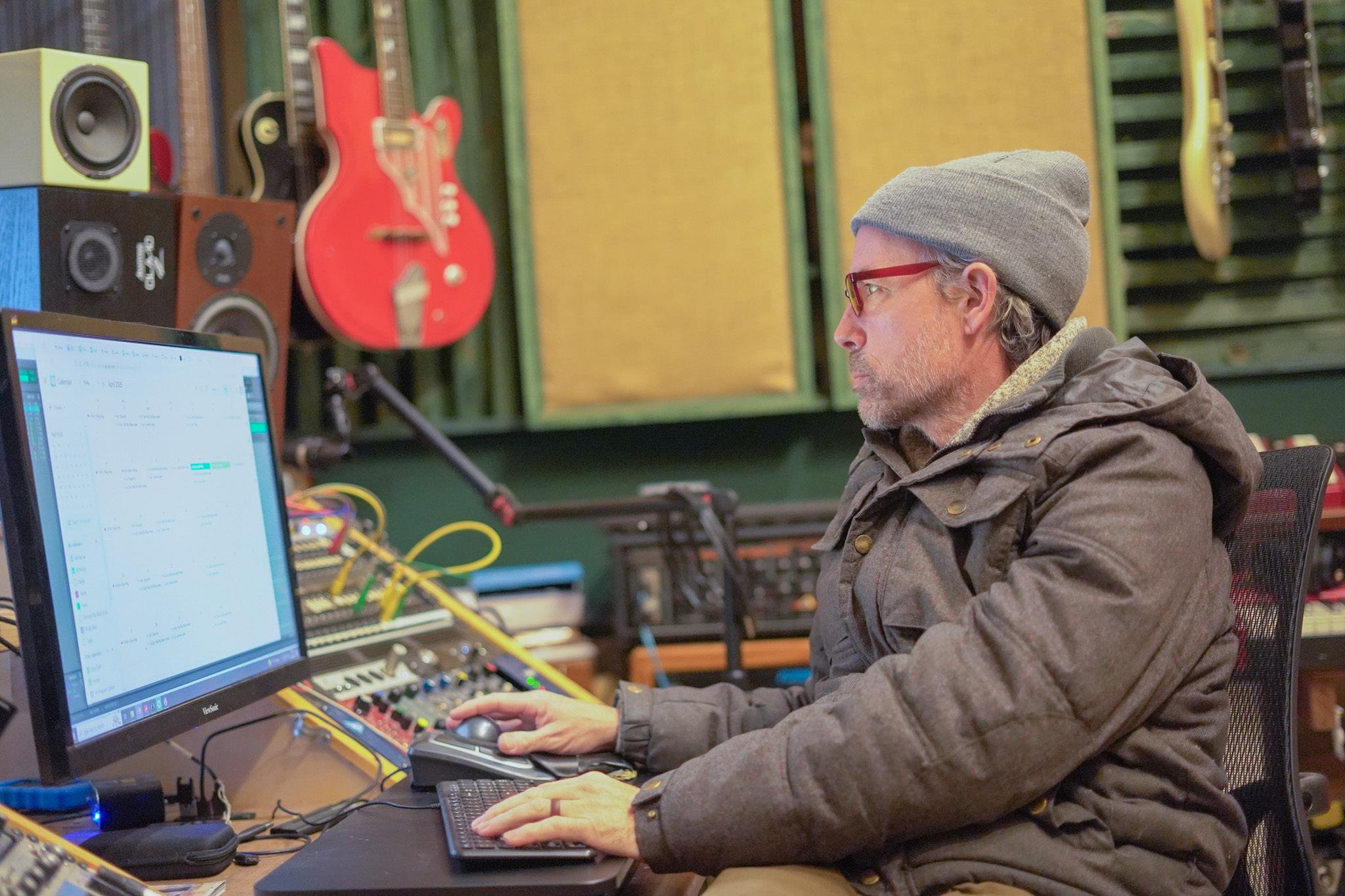
From local artist to local music phenom, Wil Reeves is changing the tune of music production in Columbia.
BY SYD MINOR
Wil Reeves, owner and operator of Centro Cellar Studio, has become a staple in the Columbia music scene, offering high-quality production services for local artists. But it took time for Reeves to find his own musical voice — his short attention span initially kept him from learning an instrument. In college, Reeves finally broke through. He formed a band with his friends called
Bockman’s Euphio (later shortened to just Bockman) and began playing shows and touring as its bassist and writer.
“I feel like I was a late bloomer to becoming a musician,” says Reeves. “I was always a music lover, a music junkie, and my early memories are, you know, wanting total control of the stereo in the car whenever we were going anywhere.”
Reeves started recording and pro-
Wil Reeves does a multitude of tasks for the musicians who hire him, from recording and editing to full production.
ducing primarily as a way to save money. He and his friends bought recording equipment because they didn’t want to pay $50 or more to a stranger for something they weren’t even sure was going to sound good, he says. So, Reeves took the reins.
The first iteration of Centro Cellar Studio took form in the basement of a house Reeves and the other members of
Bockman shared on El Centro Street. Eventually, the band started using its new home studio to its full extent with Reeves acting as the producer.
“Once we started doing that, I kind of fell in love with the process,” Reeves says. “There was no looking back after that.”
Reeves became obsessed. In 2006, he bought a house near Business Loop 70 with the intention of transforming it into a studio.
He started experimenting in various rooms with different layouts to check the sound quality. “Most houses aren’t terribly conducive to just throwing a recording set up,” Reeves says. “(You) usually have to treat the rooms and understand how the acoustics work.”
Nearly two decades later, Centro Cellar Studio has become a DIY industry standard. Reeves’ soundboard is isolated from the rest of the studio so he can hear each individual track while recording. It’s framed in a room with high ceilings and lined with woodchip panels to limit the volume of the music heard from outside.
He also has funky-shaped, ergonom-
ic chairs that allow him to fidget while he’s working.
“ His studio is the largest and most equipped,” says Marielle Carlos of Tri-County Liquidators. The local band records most of its music with Reeves, Carlos says, including its 2023 album Cut My Teeth.
“ Because of his work, we’re able to produce music on a high-quality scale so it can go into vinyl records and be sent to record shops all over the country,” Carlos says.
The first record store to sell Cut My Teeth was Hitt Street Records. Co-owner Kyle Cook has known Reeves for decades, and he can testify to the effect Centro Cellar Studio has on Columbia’s music scene. “ World class production can be done locally,” Cook says. “You don’t have to go to Chicago or L.A. or New York. We can do that here.”
Recording is more than just having top-notch technology — it’s about making sure the artist is comfortable. Centro Cellar Studio intern Annabelle Moore says Reeves brings a good energy to the recording booth, crafting a
Wil Reeves has been producing albums for decades-worth of local artists, including these:
The Adaption –It’ll Be Something Beautiful (2019)
Tri-County Liquidators – Cut My Teeth (2023)
The Hooten Hallers
– The Devil’s Egg (2024)
Pink Houses
– Roadrunner (March 2025)
Reeves (below) has a large collection of instruments, including guitars, that can be used in the music he produces with clients.

judgment-free environment that helps stimulate the creative process.
“Every person that comes in the studio is very different and they have different needs,” Moore says. “Wil has taught me to cater to every person’s different needs and how to adapt when something goes wrong and bend your process to who you’re recording for.”
Kyren Penrose is a Centro Cellar Studio regular who has worked with Reeves on multiple albums and singles for his band The Adaptation — solo music too. “ If you don’t know what you’re doing with recording, then he’ll put you in the right direction of what should be done,” Penrose says.
Reeves’ impact on the local music scene is profound. He also organizes music events for the True/False Film Fest every year.
“He definitely lets the music lead the way,” Carlos says. “In terms of mixing, he’s more on the dry side; he wouldn’t immediately add effects or cloud or flood a recording with additional, unnecessary work. He likes the music to shine on its own.”

Viewing a Zoe Hawk painting feels like stepping into a storybook. What narratives lie behind Hawk’s dreamlike works?
BY GRACE BURWELL
At first glance, the figures in Zoe Hawk’s paintings look like women who exist in real life — until you look closer, that is. With their pristine faces, meticulously coiffed hair and pastel dresses, the subjects of Hawk’s paintbrush resemble images of 1950s housewives and prima ballerinas. But this is precisely Hawk’s intention: She wants to deconstruct the fantastical nature of those archetypes.
“They never really look like real people, and that’s intentional,” Hawk says. “I want them to function metaphorically, and I want them to be this sort of dream space or fictional space.”
The St. Louis-born artist started painting in college, but her creativity was evident from a young age. William Hawk, Zoe’s father and a retired University of Missouri art professor, says Zoe was always drawing as a child — even when her siblings were distracted by Nintendo video games. Her childhood sketches told stories, too. “The narrative aspects of it were always there,” he says.
As a teenager, Hawk hoped to study fashion design, but the cost of attendance deterred her. She decided to pursue a degree in studio art at Missouri State University and received her master’s of fine arts from the University of Iowa. Her artwork has taken her across the world, from seven years spent in Qatar to her home studio in Columbia.
At the root of Hawk’s paintings are her experiences as a young woman and the transition from adolescence into adulthood, as well as stories others told her. Fitting in with peers was difficult, and her teenage years came with intimidating
Photography by Jack Calvert
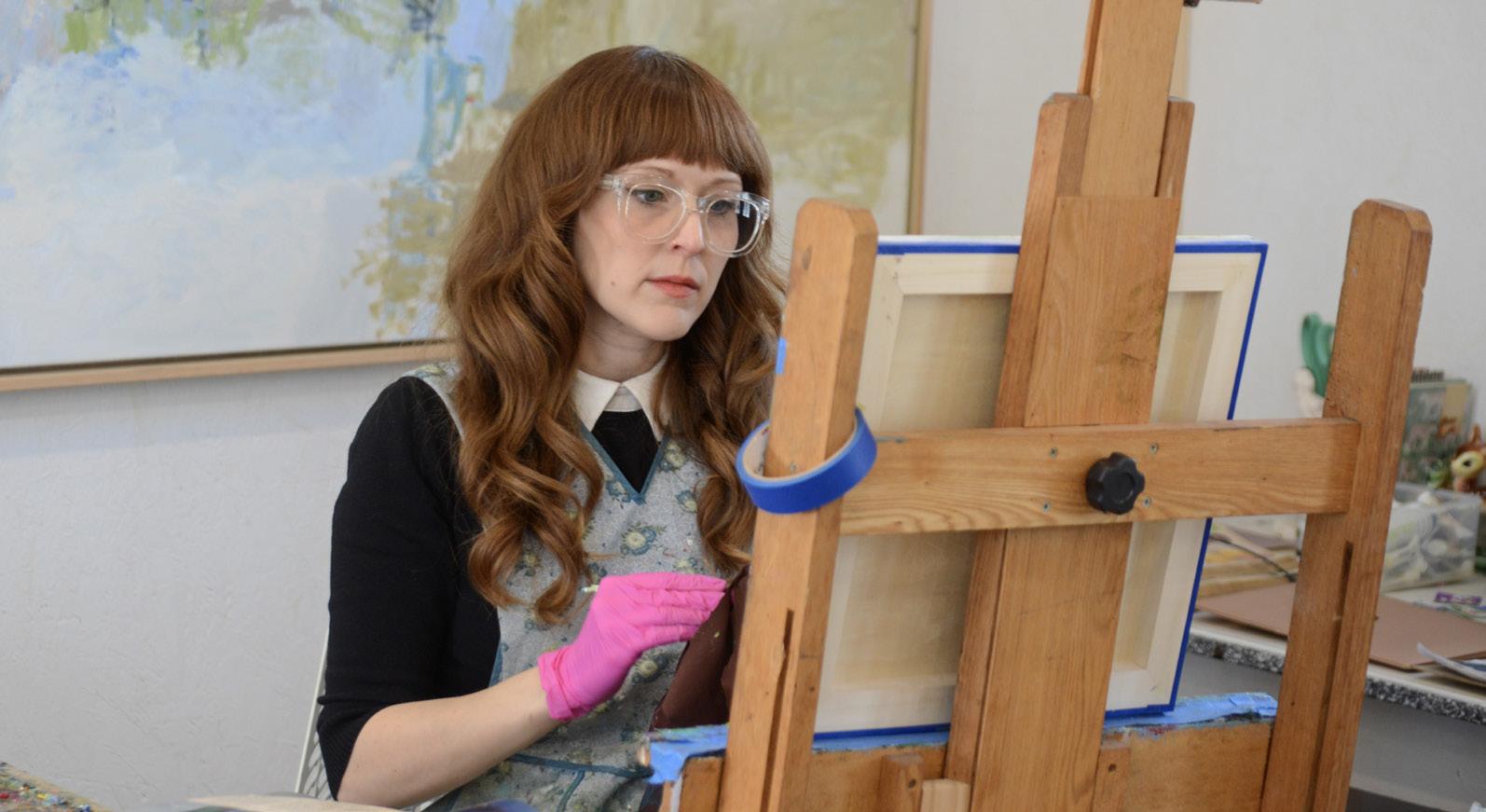
realizations about womanhood, she says.
“It comes from general observations about girl culture,” Hawk says. “A lot of those things I love, but a lot of it is a critique of some of the more rigid expectations of what you’re supposed to be as a girl and as a woman.”
The symbolic, finely-constructed quality of Hawk’s artwork extends to her creative process. It can take Hawk two weeks to complete a small 8-inch by 8-inch painting and several months for her larger pieces. Once Hawk comes up with a concept, her next steps involve finding source imagery, taking photos to test lighting and poses and making small sketches in gouache — an opaque watercolor — to narrow down the piece’s composition and color scheme.
“It’s just this lovely, enjoyable process to actually be putting the paint on the panel, but the conceptual process is like pulling teeth sometimes,” Hawk says.
Occasionally, Hawk will craft miniature cardboard sets to map out her paintings. “They end up looking like little stage sets, which I like as a metaphor for what the paintings are about.”
The result of this labor is breathtaking, the idea of feminine performance evident in every tableau. From campfires in eerily-lit forests to the visceral emotion of love letters, one can’t help but wonder how Hawk dreams up these snapshots. (Sometimes, the stories are close to home. In her painting “Preparations,” one girl painstakingly straightens long blond hair on an ironing board — a
Zoe Hawk’s art emerges from her Columbia studio. She often uses vintage magazines to spark inspiration.
beauty technique Hawk’s mother utilized in the ’60s.)
Something like magic
Hannah Reeves, director and co-owner of Sager Reeves Gallery, says Hawk’s command of light and shadows sets her apart. Reeves cites Hawk’s painting “Wolf and Bird,” in which two girls in white dresses make shadow puppets with their hands, faces aglow.
“There are some pieces in which her work with light is just kind of astonishing,” Reeves says. “Those moments in her paintings with unexpected light angles and sources, I think, are really masterful.”
Color also plays an important role in Hawk’s paintings; she finds joy in carefully selecting her palettes. Hawk says she often looks to vintage women’s fashion magazines and children’s books, incorporating retro and traditionally “girly” color schemes into her artwork.
Catch a glimpse of Zoe Hawk’s surrealist depictions of girlhood IRL. This year, her work will show at Spectrum Fine Art in Seattle and River Gallery Arts in Rocky River, Ohio, as well as in two displays abroad. See more of her work at zoehawk.com.
“Her works (are) bold, but they can be kind of quiet,” Reeves says. “She often works on a pretty small scale, too, and yet you walk up to them and it’s like this huge world opens up like you’re looking through a window into this imaginary scene — there’s this wonderful invitation in work like that.”
Hawk wouldn’t have it any other way. “It feels like magic to have this thing in your brain that you can manifest in reality for people to look at,” she says. “I couldn’t imagine myself doing any other type of artwork. I have to tell a story.” See Hawk’s art on the next page.
As a young girl, Hawk remembers playing house with her friends “like preparation for becoming a woman.” The bright pink playhouse in this painting, which Hawk initially modeled out of cardboard, is set in a gloomy, spooky forest. Hawk says she uses forests as spaces for her characters to explore the unknown, representing the mysterious future of womanhood. “That’s something they don’t quite know yet,” Hawk says. The white rabbits, of course, are a nod to Alice in Wonderland.

2
This classroom scene features the same plastic orange chairs Hawk remembers from elementary school, she says. Two girls work on a display of the Cassiopeia constellation, unaware of the mayhem surrounding them: A classmate slyly cuts another student’s hair while a sneaky outsider watches it all unfold. “The reference to Cassiopeia in particular is a little hint towards the Greek mythology behind that constellation,” Hawk says. “She was a queen who proclaimed that her daughter was more beautiful than the Nereids, and Poseidon punished her, so it’s about jealousy and vanity a little bit.”



Curtain Call
3

This painting is a callback to Hawk’s ballerina days — she danced when she was a kid and later picked it back up in college. Hawk recalls a particular memory of the prima ballerina in her group dropping her composure the minute she stepped offstage. Hawk used that moment as an metaphor for performing in everyday life. “Sometimes you feel a little exhausted after performing all day,” Hawk says.

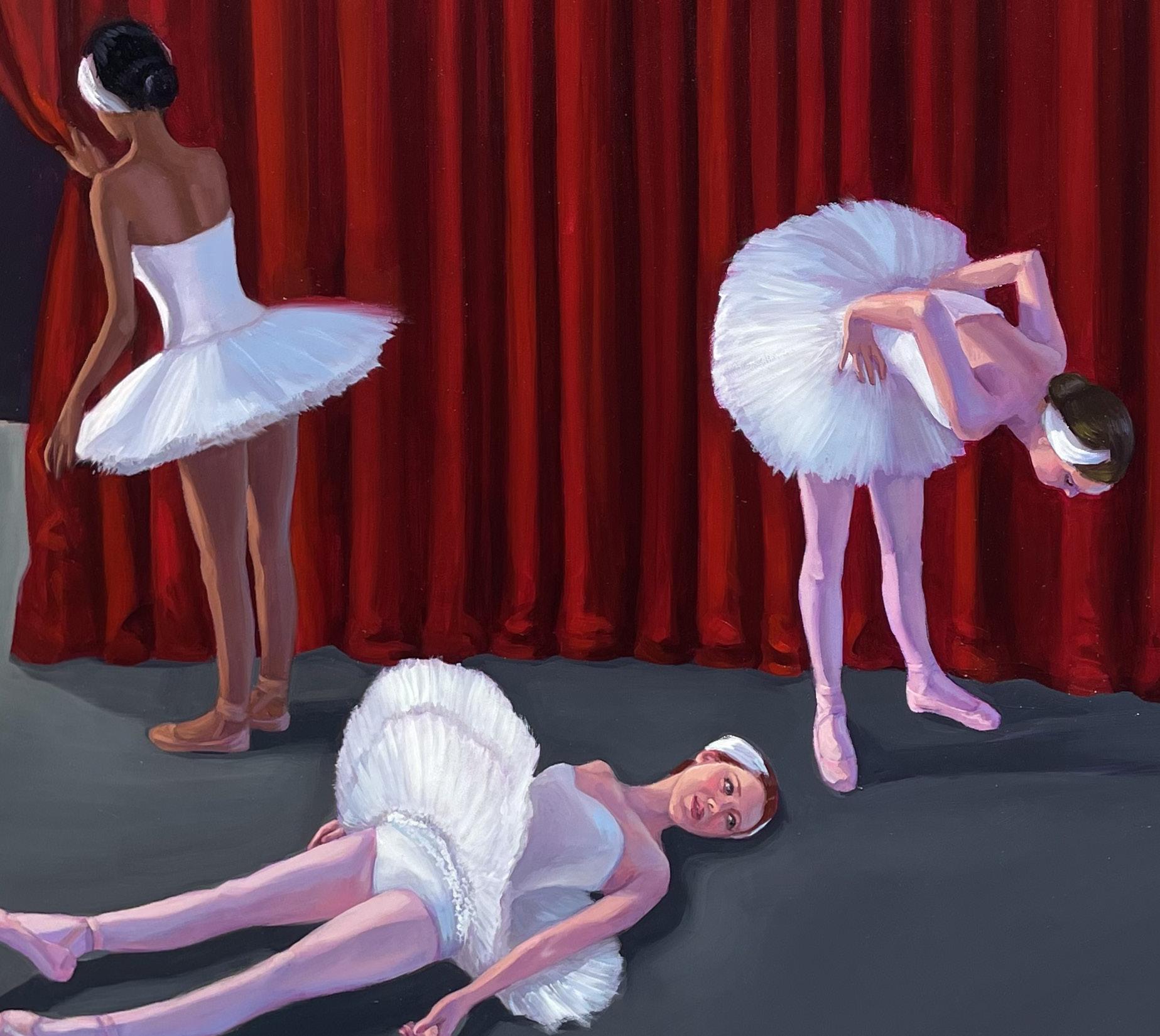
“The title comes from an old slogan that Jell-O used — I think in the 1920s or the 1930s,” Hawk says. “It was meant to be like, ‘Oh, it’s associated with femininity. It’s the dainty dessert.’” Hawk also looked at issues of Better Homes & Gardens from the ’50s and ’60s for gelatin inspiration. She wanted to use Jell-O mold imagery to symbolize feminine culture and domesticity. While the older women showing off their gelatin desserts are poised, the girls in the painting unabashedly explore their surroundings. “The younger girls are sort of running wild,” Hawk says. “They haven’t been conditioned to that domesticity yet.”

The title of this painting is a nod to The Last Unicorn, a hallmark film of Hawk’s childhood in the ’80s. The story follows a unicorn who is transformed into a woman and struggles with her new identity. “That feels like this metaphor for when you’re a girl and the world is really magical for you, there’s all this possibility,” Hawk says. Another young woman watches from beyond a fence, symbolizing a departure from childhood innocence.
Shorter-than-short stories have a spot on the shelf with Wigleaf, a globally recognized online flash fiction journal.
BY ALEX DAGGETT
Scott Garson never expected this. In 2007, he feared for his writing community following his move from Santa Cruz to Columbia and a fresh start joining the University of Missouri’s English department. In an act Garson hoped would preserve his sense of community, he sat down at his computer and Wigleaf, an online flash fiction journal, was born in 2008.
Flash fiction, a term coined in the ’90s, is a subgenre of the short story. Typically 1,500 words or less, it is described as the literary equivalent of a one-act play. Wigleaf publishes fiction under 1,000 words, though many of the stories are much shorter.
An award-winning prologue
Seventeen years ago, at the time of Wigleaf’s founding, flash fiction was still a relatively fresh concept in the world of literature, there weren’t many accessible places to read it online. In his first year of teaching at MU, Garson wouldn’t have been able to use the term “flash fiction” in his classes without receiving confused looks from his students. Now the term is used in the same breath as short stories and novellas. Garson even notes how students come into creative writing classes knowing they want to write flash fiction.
“This is amazing to me,” Garson says. “It’s actually just stunning that you see this kind of change in a relatively short time. (Flash fiction) really has made inroads into people’s consciousness.”
This year, Wigleaf was ranked the 17th best small literary press by author

Clifford Garstang, who analyzed factors like Pushcart Prizes for small presses. Wigleaf is one of only two online-only publications that are ranked in Garstang’s top 20; the rest publish print editions. Garson never could have predicted that this could happen with the site’s independent status and lack of financial capital compared to competing sites.
A turning point in the popularity of Wigleaf came in 2013 when author Margaret Atwood tweeted a link to the website. Garson was out at dinner with his wife, making an effort not to check his phone, but he couldn’t ignore the buzzing. “We just blew up at this point,” Garson says. “I started getting notifications on my phone going nonstop.”
Garson runs the website himself, shouldering the web design and coding, but he has help on the editorial side. He kick-started an internship program in the late 2010s through MU, where students go through story submissions and help pick which pieces run in the journal.
The editorial team gathers once a week to discuss a handful of potential stories. MU student Nina Schmolzi is in her second semester as the assistant
17th anniversary on Jan. 17. Coincidentally, it was just ranked as the No. 17 small literary press. That’s a lot of 17s!
Interested in submitting your own flash fiction? Wigleaf accepts submissions the last seven days of the months when class is in session — August to November and January to April. To apply and find guidelines, check out the publication’s submissions page at wigleaf. submittable.com/ submit. You can read published works on Wigleaf’s main site.
editor for Wigleaf, tasked with contacting the authors about their work. Schmolzi says Garson extends grace to pieces they would normally reject and reaches out to authors to help edit pieces for submission.
MU creative writing professor Julia Talen also noted how Garson cares deeply about advocating for writers. “Especially for emerging authors submitting to literary journals and getting their first publications out there, editors who work with writers and take care of them are really meaningful,” Talen says.
Wigleaf does not charge a submission fee for writers, unlike many other literary journals. Garson says he doesn’t want to charge writers who may have given up economic opportunity to pursue their work.
The rise of short-form content, especially through social media, has pushed people to consume information in more condensed forms. Flash fiction bridges this gap between short-form content and literature.
“A lot of people don’t have the time or energy to read longer-form fiction or nonfiction,” Schmolzi says. “Flash fiction is super accessible. You can read most of our stories in under five minutes, and I think that really appeals to people.”
‘Why
In her lyrics, Chloe Hoecker, an up-and-coming country musician, proclaims her love for Missouri — and her intentions to stay rooted here.
BY NEALY SIMMS
Chloe Hoecker is forging her own path along the Missouri River while staying in her home state. “I’m not moving to Nashville,” says Hoecker, who’s a native of St. Elizabeth, a town 45 minutes south of Jefferson City. “Even Columbia is a little big for me.”
Her latest single, “Missouri River Run,” is a spirited, lyrical love letter to the cherished landmarks and cities along the muddy riverbanks of its namesake. The fiddle-infused anthem takes listeners on a riverside journey, serving as both a defiant declaration of Midwestern pride and a warm invitation to challenge the misconception that Missouri is an “overlooked, driven-through” state.
“The Midwest offers a lot to the rest of the country, and people just kind of forget that,” Hoecker says.
At the core of her artistry is a commitment to staying grounded in her small-town roots — thus, she adopted the moniker “Missouri’s country sweetheart.” Hoecker’s lyrics deliver a distinctive combination of sweetness and sass, evident in her deceptively charming breakup anthem, “Bless Your Heart.” One moment, she’s the poster girl for politeness (“I ain’t one for cussing/And I don’t like to fight”). The next, she’s delivering the verbal equivalent of a honey-dipped dagger (“Truth is, boy, I’m being nice/But underneath it’s cold as ice”).
Her songwriting stems from her own life experiences, but Hoecker also draws inspiration from country music divas like Miranda Lambert, Kacey Musgraves and Kaitlin Butts.
Hoecker plans to release five more songs within the next year. She notes that no two songs of hers are alike,
though certain elements remain non-negotiable. At the top of that list is having a “gosh darn fiddle” in her band.
“She’s got this knack for hometown music songs that just feel like they’re straight out of Missouri’s soul,” says fiddle player Randi Twehous, who has collaborated with the singer on live performances for about a year. “People in this state crave tunes that they can connect to, stories that feel like home.”
Learning the way Hoecker’s natural talent emerged early. As a child, her parents discovered her playing “Jingle Bells” on a toy keyboard and teaching herself to play guitar without any formal instruction. Her shyness initially concealed her vocal abilities. That is until her father, Shane Hoecker, offered her an electric guitar under one condition: she had to start singing in front of the family.
When Hoecker was 9 years old, her dad enlisted a family friend, Randy Voss, to give her guitar lessons at his glass and mirror shop in exchange for beer. “Every Friday night when his band wasn’t playing, he would swing by the shop, and as long as my refrigerator had Busch Light in it, they would play,” Shane Hoecker says.
She began performing songs at local bars with Voss’s country rock band, Firecreek, at age 11. There, she gained experience singing live in front of crowds, despite thinking she “didn’t sound very good” at the time.
Voss, who died in 2021, continues to influence Hoecker’s musical journey. His approach to practice and perseverance remains in the back of her mind during challenging moments. “If I’m like, ‘Oh, I can’t do that,’ I kind of hear

Chloe Hoecker plays the song “Stand by Your Man” by Tammy Wynette during her weekly gig at West Main Pizza in Jefferson City. Hoecker says this and “These Boots Were Made For Walking” are her two favorite songs to cover while performing.
Chloe Hoecker’s music, including “Missouri River Run,” can be streamed on all major streaming platforms. She has upcoming shows in several towns in Missouri, including TJ’s Bar & Grill in Holts Summit on March 28 and April 25. For Hoecker’s full schedule,see chloehoecker music.com.
him saying, ‘No, you can do this, you are good enough, you just have to put in the work,’” Hoecker says.
At 15, with a guitar and a mic stand in front of her, Hoecker started performing solo gigs across the state.
Now 20, with hundreds of shows under her belt, Hoecker has performed original songs and covers at churches, weddings, bars and events like Columbia’s Country Music Fest and First Fridays.
“I just hope people can see that I’m working hard at this, and this is what I love,” she says.
Despite her growing success, Hoecker maintains a humble lifestyle embedded in her country upbringing. “She’s a very simple person; she buys her clothes from the thrift store, besides her boots,” her mother, Lanelle Hoecker, says.
Success for Hoecker comes from being able to do what she loves for a living as an independent artist — without a manager or record label calling the shots. “No matter how big I get,” she says, “I’m still just a little small person from St. Elizabeth, Missouri.”


What’s on the menu for Unbound? An indulgent lineup of authors and books.
BY BRIANNA DAVIS, AUDREY ELLIS AND JASMINE JACKS O N
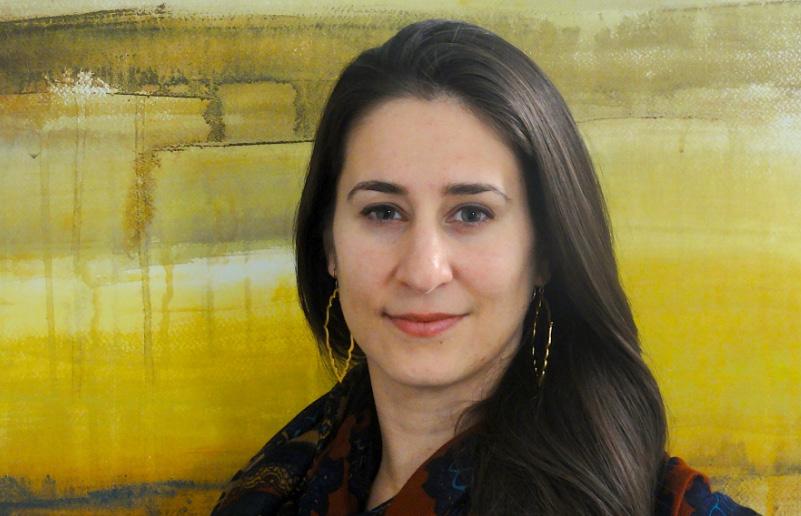
Science-fiction author Brenda Peynado will return to Unbound to discuss her latest book, Time’s Agent
Time’s Agent is a sci-fi novel about an archeologist, Raquel, who, after humanity’s discovery of pocket worlds, is tasked with exploring these newfound technologies. After a devastating loss, she is looking for “one last mission for redemption” for her daughter, her wife and the world she left behind. When Peynado first began writing Time’s Agent, she was examining her own relationship with motherhood and legacy.
“At the time I was writing, I was ambivalent about having kids,” she says. “By the time I finished writing, I had had a baby. I was thinking a lot about my own complicity in the ills and sorrows of the world.”
Peynado began writing while attending college at Wellesley College in Wellesley, Massachusetts, as a computer science major. After taking a break from writing to work in computer security, she quickly realized how much she missed writing.
“I thought, ‘I don’t care if every server in the world goes down,’ but everybody else will. But I do care if I write again, even though nobody else will,” Peynado says. —A.E.
Book that feeds Peynado’s soul Walkaway by Cory Doctorow Find Peynado at Unbound Where We’re Going, We Don’t Need Roads panel

Julie Buntin’s writing is private and painstaking. She needs a completed first draft before she can find a sense of direction in her story. Then the rewrite begins — a time Buntin calls “quiet, focused searching and reflecting.”
“It’s like living a little bit of a secret life, alongside your regular life at all times, because a book takes up a lot of space in your imagination and mind,” Buntin says.
Her first novel, Marlena, took four years to write. It wasn’t until a personal tragedy involving a childhood friend that she found the motivation to commit. “The book was sort of my way of processing that. It kept me going,” Buntin says.
Marlena follows a female character reflecting on a childhood friendship ending due to addiction. The main character, Marlena, is complex. Buntin
Poet, author and professor — Gary Jackson wears many creative hats. Jackson is co-editor of The Future of Black: Afrofuturism, Black Comics, and Superhero Poetry
This work contains both written and visual topics of Black pop culture, Black superheroes and antiheroes, afrofuturism and poetry. It blends a compilation of on-theme poetry written by various poets selected by Jackson and his fellow co-editors. Afrofuturism is a genre that combines Black history and culture with science-fiction that aims to imagine alternative futures and reclaim Black agency.
“I’m really fascinated by how imaginative Afrofuturism stories can be,” Jackson says. “I do think Afrofuturism isn’t rooted in just storytelling, because there’s Afrofuturism art, music, visual arts and fashion. Those aspects of Afro-

compares this to nacho dip.
“It’s a teenage craving,” Buntin says, “the beans, cheese and bag of tortilla chips you eat with your friends at 1:30 in the morning that really hits the spot.”
Books that feed Buntin’s soul
—J.J.
My Brilliant Friend by Elena Ferrante The Bee Sting by Paul Murray Dinner at the Homesick Restaurant by Anne Tyler Find Buntin at Unbound Writing Addiction panel

futurism also tell that story.”
Jackson cites his inspiration for poetry in poets Ai, Lynda Hull and Lucille Clifton. He recommends his book for those interested in “Black, speculative storytelling” and fans of N.K. Jemisin and Octavia Butler.
A.E.
Book that feeds Jackson’s soul
James by Percival Everett Find Jackson at Unbound
Love of a Black Planet: Afrofuturist Poetry panel
Cynthia Manick is the author of two poetry collections, Blue Hallelujahs in 2016 and No Sweet Without Brine in 2023.
“The ability to be a writer helps me really think about what words mean,” Manick says. “In my poems, every word means something. I don’t have throwaway lines.”
Manick completed a Master of Fine Arts at The New School in New York City. Her personal life, family history and emotions — like joy — are recurring themes in her work. “Poetry gets you close to empathy, and empathy gets you close to every part of the human experience,” Manick says.
The collection of poems titled The Future of Black: Afrofuturism, Black Comics and Superhero Poetry published in 2021. It explores identity within Black culture through creative genres such as fantasy and science fiction.
“Everybody knows about Superman, the cape and the X-ray vision,” Manick says. “It’s using that common knowledge and relating it to how we feel about ourselves.”
Elijah Burrell is a poet who views the world through images, rhythms and fleeting moments of conversation. As an English professor at Lincoln University in Jefferson City, Burrell has spent over a decade teaching and writing.
His latest book, Skies of Blur, discusses a time of isolation and introspection. No surprise, considering he mostly wrote this story during the pandemic.
“A lot of the poems in that book have the tone of alienation,” Burrell says. “There’s a sense in that book of the speaker having to go on an internal journey and wrestle with the past and what the future can be.”
Burrell’s creative process is often sparked by small, seemingly ordinary moments. It could be a phrase overheard in passing, words on a road sign or the juxtaposition of two unexpected images. His Notes app is a constant companion, filled with fragments that
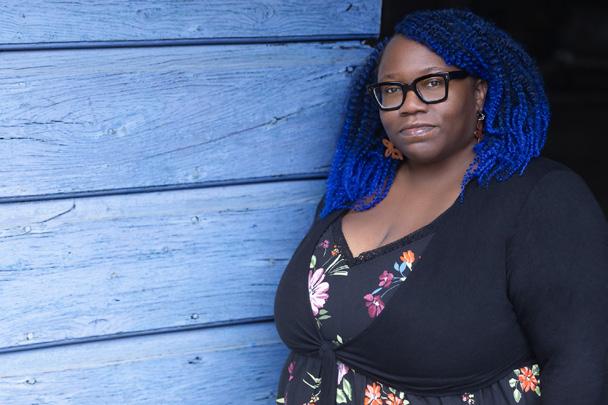
Alongside co-editors Gary Jackson and Lynn Lawson, Manick sought to elevate poems that reimagined the Black experience, such as works that don’t fit within traditional poetic themes of love and politics.


“In the Black collective, we’re told we laugh too loud, dream out of our lane, sing too high and dance too hard,” Manick says. “Afrofuturism and this book counters that, so we imagine ourselves as anything you want to be — stars, bulletproof and free.”
Books that feed Manick’s soul Head Off & Split by Nikky Finney When My Brother Was an Aztec by Natalie Diaz Find Manick at Unbound Love of a Black Planet: Afrofuturist Poetry panel
—J.J.

later evolve into poetry.
At the heart of Burrell’s work is a desire to connect, something he hopes to do when he shares Skies of Blur at Unbound. “It’s not a happy read,” he says. However, it’s not all doom and gloom. “There is beauty to be found at the end.”
B.D.
Books recommended by Burrell related to his book
Actual Air by David Berman leadbelly by Tyehimba Jess
Find Burrell at Unbound Die Laughing panel
A. Kendra Greene, writer and a visiting assistant professor of creative writing at MU, is a collector of ideas and an explorer of the unnoticed. Guided by deep curiosity and a passion for storytelling, her writing is shaped by an insatiable need to understand the relationship between text and image, how concepts transform into something tangible and how our experiences shape who we are.
Greene’s latest book, No Less Strange or Wonderful, demanded more than her previous projects. The book explored not just ideas, but herself, forcing her to reckon with the fleeting connections that make up life.
“It’s a thing that had to be written,” Greene says. “It made me realize that the way I think and move in the world is built on an uncountable number of fragments. Offhand comments, little facts, ideas and stories from people I love, from strangers, from things that aren’t even people.”
Greene admires the ability literature has to be a visual art for people — it’s always absorbed either on the page or the screen as we think about the importance of reading.
At Unbound, she hopes to continue that conversation as someone who is eager to listen, share and discover.
B.D.
Books that feed Greene’s soul
Dear Memory by Victoria Chang Blackouts by Justin Torres Find Greene at Unbound You Can’t Handle the Truth panel
Check out these authors and more for yourself. The Unbound Book Festival is April 17-20. See information at unboundbookfestival.com.
For the festival’s 10th year, Vox peeks behind the curtains of the beloved community celebration of books.
BY OLIVIA MAHL
Alex George, co-executive director of Unbound Book Festival, peered from behind the curtain at the Missouri Theatre. Nobody knew what was going to happen when poet Mark Doty and novelist Michael Ondaatje took the stage. But as they wrapped their interview, the audience erupted into cheers. George says it was magical to watch two utterly brilliant people hold the audience in the palms of their hands.
That was April 2016, the first year of Unbound Book Festival and one of George’s favorite memories. This year, from April 17-20, the festival will celebrate its 10th year.
Unbound has blossomed over the decade, evolving from a one-and-ahalf day event into a four-day event. George got inspiration for Unbound when he was on his book tour for his first U.S. novel, A Good American. Many of the book festivals he visited left a mark on him and inspired him to bring that experience to Columbia. “Columbia is a town that’s always loved its festivals, and with three universities, it’s a very literate community and a place that loves its books,” George says. “It just seemed like an obvious kind of thing to do.”
The first four years of the festival
were held at Stephens College. Despite not having a festival in 2020 due to the pandemic and being an online festival in 2021, the number of attendees and authors at Unbound has only grown. As a result, the festival moved to downtown Columbia. “I think we had something like 3,500 people in 2016,” George says. “That number has more than doubled since then.”
This year, the festival starts with a 21-and-over LitCrawl on Thursday, April 17. “That’s an interesting option for people who like readings, they like performance, they like community, they like crawls, they like visiting a bunch of our local spots,” Katie Doherty says, president of the Unbound board.
Unbound’s 2025 keynote speaker, Min Jin Lee, will speak at Jesse Auditorium. She is the author of Free Food for Millionaires and Pachinko.
By Columbia, for Columbia Unbound is 100% volunteer, 100% for the community and 100% free (other than the Write On! Workshop).
The festival being free of charge was established on day one. As a result, all money made from previous festivals contributes to bringing in authors and keynote speakers. George says that people devote hundreds of hours to make sure this festival happens. “Everyone has invested in it, and it sort of reflects the community that it exists in,” he says.
The board and committee of the festival are always looking for feedback from the community. In 2018, there was criticism of Unbound lacking diversity. After critical reflection of the issue, they brought in more representation.
Phong Nguyen, a local author, started volunteering with Unbound in 2019. He says the conversations regarding such criticisms were fair and
Hundreds attended the opening of the first Unbound Book Festival in 2016, featuring a Q&A between world renowned writer Michael Ondaatje and acclaimed poet and memoirist Mark Doty.
important for the festival to address. “There are inherent challenges to being in a region with less diversity, but that doesn’t absolve us from the responsibility to try our hardest to represent the breadth of voices in the literary world,” Nguyen says.
This year’s festival features a range of diverse narratives, including a panel on Afrofuturism — an intersection of Afrofuturism, Black comics and poetry — to a panel on New Yorkrican fiction, featuring Puerto Rican writers from New York.
Unbound organizers hope that everyone gets something out of the festival. Carrie Koepke, co-owner of Skylark Bookshop, gets to interview one of


Unbound Book Festival’s new director wants you to get in the flow of a good read.
BY MERCY AUSTIN
s the Unbound Book Festival approaches, a new voice is stepping in to lead. Kerry Townsend joins founder and co-executive director Alex George for this year’s fest as she prepares to take over as executive director next year. Townsend has been the library media coordi-

nator at Columbia Public Schools for the past 15 years. In that role, she helped pioneer Authors in Schools, a program that brings authors into public schools during Unbound.
Peggy O’Connor, former Unbound liaison for Authors in Schools, says she has been impressed by Townsend’s extensive knowledge of books, authors and how to engage with readers. “I have no doubt she’ll be an exceptional executive director,” O’Connor says. “She will work tirelessly to continue this festival and bring it into the next decade beyond the first 10 years under Alex.” Vox talked to Townsend about Unbound and why books matter.
her favorite authors, Jennifer Haigh, at this year’s fest. “When the opportunity came, Unbound knew that I was thrilled about this new book she has coming out. So, it was a good fit,” Koepke says.
For attendees who don’t regularly attend author events like Koepke, Doherty still hopes they walk away feeling more knowledgeable and relaxed.
“I hope that people share a love of books and reading,” Doherty says. “But even if they don’t already think about that or consider themselves a ‘capital R reader’ or writer, it’s so refreshing to be in a place where people are discussing ideas and information. You see so many different perspectives, and you always learn so much, and it’s kind of a little spa for the brain.”

What is your favorite Unbound memory?
Honestly, the year of COVID was pretty special, because, you know, schools were disrupted and we had all these mask mandates. Everything was kind of crazy. In such a disruptive time, it was nice to know that students still had the ability to interact and meet with authors. And it was a communal experience across the district.
Why are fewer people reading?
I think providing the experience of getting into the flow of a good book is something everyone needs. If you’re a reader, you know that experience — and you know what it’s like to be im-
Keynote speaker Min Jin Lee

7:30 p.m. April 18, Jesse Auditorium
Min Jin Lee won a Columbia-based story prize in 2002. Now, she’s returning as Unbound’s keynote speaker.
BY BRIANNA DAVIS
No one asked me to write a book,” author Min Jin Lee says. But she wrote one anyway. She didn’t have a contract or an agent encouraging her. Nevertheless, she spent 25 years answering one of her biggest questions: How can children hate other children based on ethnicity — an immutable characteristic? Her contemplation on this question led to Pachinko, a novel that would cement her place in the literary world.
Lee’s journey has been anything but straightforward. She left a career as a lawyer at age 26 to pursue writing full time, an uncertain leap of faith that would take over a decade to flourish. Her process for writing is meticulous. Her books aren’t just born; they are built through exhaustive research, hundreds of interviews and endless drafts. The path is long, but she embraces the change.
“Very often, it’s difficult,” Lee says. “It’s difficult to do interviews. Because they’re looking at you and going ‘Do
mersed in a book and not want to put it down and not want to let it go. And you’re never going to become (a reader) if you don’t figure out what that feels like. The social aspect of books is really important, like talking about books with other people. That’s why people belong to book clubs. That’s why Goodreads exists.
How does Unbound help cultivate a love of reading? Getting that opportunity to meet an author might be the thing that turns you on (to reading). Maybe you haven’t been a reader lately, or maybe you haven’t read poetry or maybe you always read nonfiction. You hear

you have an agent?’ No. ‘Do you have a contract?’ No. ‘How long have you been working on it?’ Eight years.”
But that doesn’t deter Lee. Instead, she takes it head-on. Her books are deeply personal, yet reflect universal experiences. Her work is a testament to resilience, an insistence that stories matter even when no one is asking for them.
At the Unbound Book Festival, Lee is not just the keynote speaker — she is returning to a place that played a pivotal role in her career. The Missouri Review awarded her the Peden Prize for an early piece of Pachinko before she had even published her first novel. “It meant the world to me,” Lee says. “They took me seriously.”
For Lee, books are more than just stories. They are acts of liberation. She worries for Gen Z and urges young people to reclaim their attention, to choose knowledge over distraction, especially with phones. She encourages learning through books as a more nourishing alternative.
“I use my phone, and I’m very clear that it is a tool for me,” Lee says.
“I am not its tool.”
As Lee prepares to step onto the stage at Unbound, she says that she is coming home to a place that believed in her before the world did.

an author at the festival — now you read fiction; you pick (reading) up again.
What are you excited about for the festival this year? I’m particularly excited about just taking it all in, thinking about it from the other side, because I’ve always been more involved with Authors in Schools. This year, I’ve enjoyed a great deal of learning from Alex. I’m excited about Min Jin Lee, our keynote. Even if you haven’t heard of an author, there will be a panel of interest to you. You don’t have to spend the whole day there. You can go to one or two panels, but give it a try.



AFTER A LIFE-CHANGING ACCIDENT IN 2021, DAVIS TAYLOR IS TAKING BACK THE COURT AND COMPETING FOR THE U.S.
STORY BY DAVIS WILSON
DESIGN AND ILLUSTRATIONS BY
SYD MINOR
PHOTOGRAPHY BY YI GAO



Garrett and Trish Taylor sat in the University Hospital waiting room, trying to wrap their heads around the unimaginable. Their 14-yearold son, Davis, was undergoing emergency spinal surgery following an early-morning ATV accident. What now? The two parents sat together from around 1 to 6 a.m., pondering how to move forward. As the sun rose that morning in September 2021, the uncertainty of Davis’ future became clear.
Suddenly, Trish had a vision—or maybe a prediction. She knew, somehow, that her son, the same one who had just lost the abilty to move his legs, would one day represent the United States of America.
Three and a half years later, that premonition came true. Davis Taylor is representing the United States by playing wheelchair basketball for the 2025 U.S. Men’s Under 23 Team — at only 18 years old.
When Davis gets home from school, he does his homework and then turns on his PlayStation to wind down. Right now, he’s on a College Football 25 Ultimate Team kick. His dad can attest: “I get the credit card charges all the time online.”
Davis is a fan of Marvel movies, and Avengers: Endgame is his favorite. He loves listening to rap and hip-hop, particularly Future, and he’s a huge Kansas City Chiefs fan. February’s Super Bowl loss still bothers him.
Most of his time is spent playing and practicing basketball. Davis is a smart player, a good teammate and an excellent midrange shooter. “That’s my go-to shot,” he says. He scored a career-high 29 points at a tournament in Dallas this past December.
Davis is like any other 18-year-old dude, except for one thing. He is paralyzed from the chest down.
Sports have been a part of Davis’ life from the beginning. “Since he was 2 years old, all he ever wanted to do was roll a ball back and forth to me, or bounce a ball back and forth or kick a ball,” Trish says. “When he was 5 or 6 years
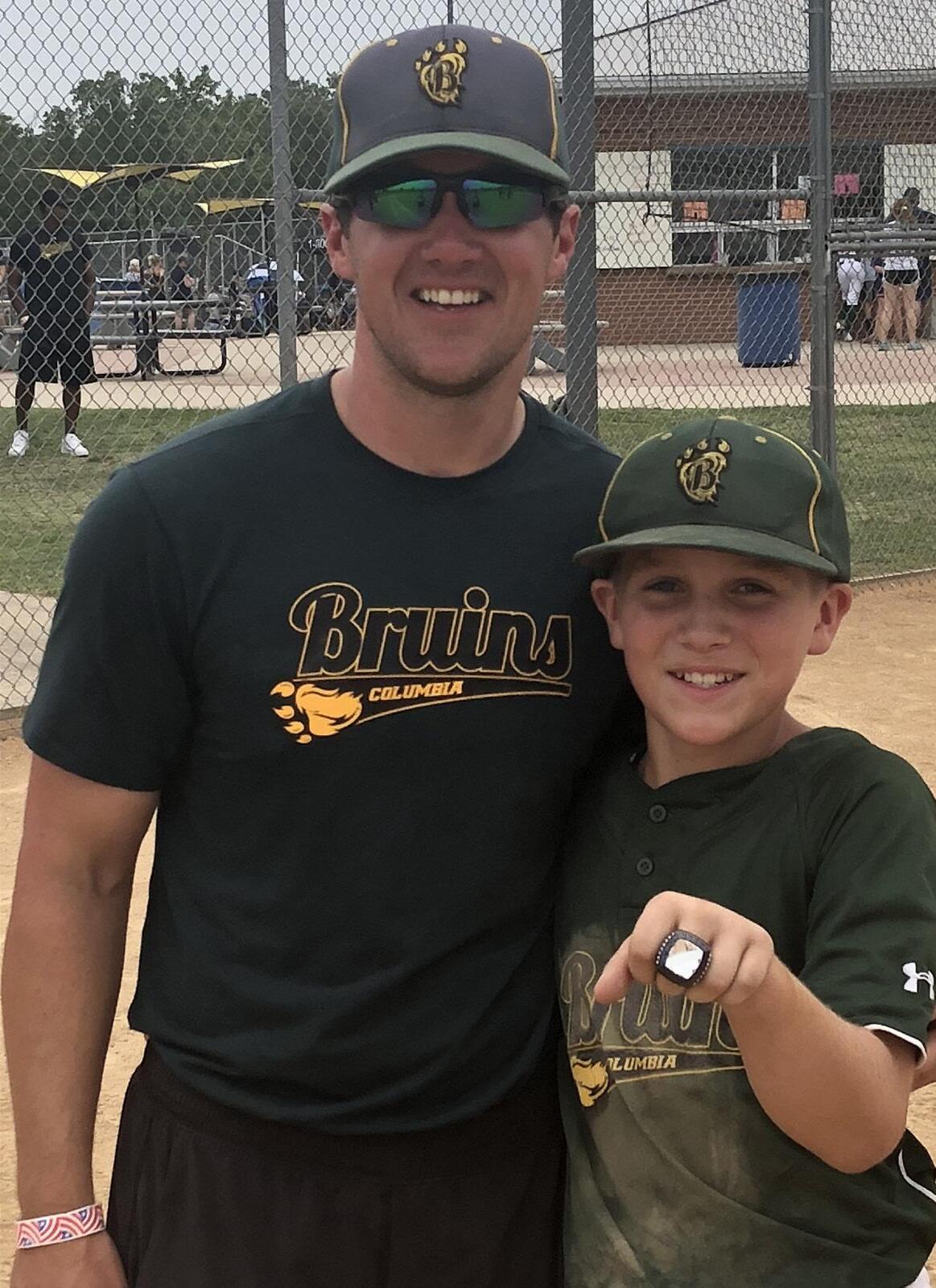


Davis’ friends, family and faith have long been a huge part of his life. He shows up for his friends by going to their school events at Rock Bridge High School (above right).

old, he would sit and watch an entire Cardinals baseball game on TV, which is unusual for a kid that young.”
He learned to read with the names on the back of players’ jerseys. One of his first memories was playing basketball on the Itty Bitty Ballers church league team at age 4. Davis has always had the competitive juice. When he gets on the court, he’s different from the laid-back guy his friends and family know well.
“I mean, he hates to lose,” says Justin Towe, Davis’ longtime baseball coach. “He wants to win no matter what he’s doing.”
Davis also picked up baseball around 4 years old and played both basketball and baseball until high school. He played middle infield, switching between second base and shortstop.
“Since he was 2 years old, all he ever wanted to do was roll a ball back and forth.”
-Trish Taylor, Davis’ mother
His father Garrett played a good bit of baseball when he was younger, so he coached Davis and his friends’ team. He had no trouble recognizing Davis’ baseball gift. “He had better hands than I did,” Garrett says. “He was a hell of a baseball player.”
Sept. 3, 2021, was supposed to be a normal Friday. The weather in Columbia was ideal. The temperature settled in the mid-80s for most of the day, sunny with a comfortable breeze. The Rock Bridge High School football team played a home game against the Smith-Cotton Ti -

gers and pummelled them, 50-0. Davis and his friends, all freshmen at the time, witnessed Rock Bridge’s first win of the season and followed it up with a celebratory meal at Las Margaritas. When they finished eating, the group headed to Davis’ friend’s house to hang out—just like they typically did on Fridays.
The friend group was inseparable, having grown up playing sports together. Around 12:45 a.m., they decided to take the family’s ATV to the gas station to pick up some snacks. Davis remembers riding in the vehicle alongside four of his closest friends, and then, suddenly, darkness. Everything went blank.
Trish and Garrett remember the phone call well. “That’s a phone call every parent dreads,” Trish says. “It’s one of the most awful things you could ever imagine happening in your life.”
They were told by a fellow parent that the boys had flipped over a ATV and that Davis could not move his legs. Trish, who is a doctor, immediately knew what that meant. “I just wanted to get to him as quickly as possible so that I could reassure him that everything was going to be OK,” Trish says. Garrett and Trish went to the accident site and met Davis, who had already been loaded into an ambulance. They followed him to University Hospital.
For two weeks following his accident, Davis was confined to his hospital bed. Outside of his family, which included his brother Dylan and sister Olivia, no visitors were allowed due to COVID-19 restrictions. Beyond the hospital’s walls was a community of people who just wanted to see Davis. They wanted to offer support. To let him know that he was not alone.
On Sunday morning Sept. 5, close to 200 people — including close friends, classmates, teammates and strangers — gathered on top of a parking garage adjacent to Davis’ hospital room for a prayer vigil. “I saw a lot of people out there that were supporting me,” Davis says. “It definitely uplifted me at a time when I really needed it.”
Toward the end of the event, Garrett, who had been inside with Davis, went outside to join the vigil and spoke. He thanked the crowd before finishing with a call to action. “It’s time for you guys to be there for him,” Garrett says. “I know you will be.”
And, indeed, they were.
“I don’t think there are words to explain how important that has been to Davis and his recovery,” Trish says. “Those kids — some of those kids he’s been friends with since kindergarten. Some of them even before kindergarten. Those are the kids he played (with in) Little League football, Little League baseball and traveling basketball. That was probably one of

my biggest fears — that he was going to lose that friend group. That they would go on living a normal high school life and leave him behind.”
Davis and his parents spent two weeks at University Hospital in Columbia, two months at a research hospital in Chicago and seven months at the Ronald McDonald House in Louisville, Kentucky. In between rehabilitation and treatment, he texted and played PlayStation with his friends often. But his parents wanted more for him. The competitive boy they knew was still alive was trapped inside of a body that could no longer run or jump. Somehow, some way, the athlete within Davis needed to play.
“It definitely uplifted me at a time when I really needed it.”
-Davis
Taylor, about the vigil outside his hospital room
In September 2021, Davis was in an ATV accident that paralyzed him from the waist down. Just a couple months after the accident, Davis started playing wheelchair basketball — which he absolutely hated at first.
Davis (at right) transfers himself from the wheelchair he uses for playing basketball to one for daily use.

While in Louisville, Davis’ doctors recommended he try wheelchair basketball through a local group, the Louisville Mustangs. After going to his first practice in November 2021, just a couple of months after the accident, Davis knew one thing right away: He absolutely hated wheelchair basketball.
He had a hard time sitting up in his chair, he was not fast and he couldn’t shoot. He had been an excellent player on the hardwood. Now, he couldn’t make a layup. “The first time I tried it, I really didn’t like it,” Davis says. “It made me mad, not being able to be good at it.”
In January 2022, Davis met Matt Bollig at Arrowhead Stadium after a Kansas City Chiefs playoff loss to the Cincinnati Bengals. Matt, who is also in a wheelchair, approached Davis and told him he looked like an athlete and that he wanted him to come play for his team. Matt coaches a wheelchair basketball team in Kansas City called the Kansas City Kings.
Davis started practicing with the Kings in September 2022, and it was not too long before the game came to him. On the court, he found a competitive outlet and a group of people who encouraged him and helped him improve. Off the court, he had the same support.
He and his friends met once a week with Luke Neal, the Columbia area director of Young Life, a nonprofit international Christian ministry. Luke took the boys in and helped them build and strengthen their relationship after the crash.
“He was instrumental in keeping the group
together,” Trish says. “(Luke) has met with them pretty much every Sunday for three years and mentored them.” The group talks about life and Christianity, something that has become an important part of Davis’ life. Davis’ seriously competitive fantasy football league and his friends, who like to surprise him at his tournaments, are also important to him. All these factors motivate him to keep playing well.
Over the past few years, Davis has not only stayed with wheelchair basketball—he has excelled at it. “He’s our No. 1 shooter,” Matt says. “He’s a knockdown shooter; he’s very competitive. He wants the ball in his hands. If we are not hitting shots, we can normally go to Davis. And then everybody feeds off him.”
Last summer, at a game in Charlotte, North Carolina, the Kings held a comfortable lead over their opponent for most of the game. Charlotte stormed back and took a late two-point lead with almost no time left. Matt drew up a play that would get Davis open behind the 3-point line. It worked to perfection.
Davis’ shot slipped through the hoop as the buzzer rang. With Davis turning in more performances like these, coaches started to take notice. He went to a camp at Auburn University, where he met its wheelchair basketball head coach, Robb Taylor. The two formed a good relationship that led to Davis accepting a scholarship offer to play at Auburn beginning next year.
Last fall, University of Missouri wheelchair basketball coach Ron Lykins, who formerly coached the national team at the Olympics,
The International Wheelchair Basketball Federation Men’s U23 Wheelchair Basketball World Championship is an international tournament featuring male wheelchair basketball players. This event is held every four years. It was first held in 1997 in Canada. The Americas Championship will be held April 2-6 in Bogotá, Colombia.
Davis practices for the U.S. Men’s U23 wheelchair basketball team with the Kansas City Kings and at Mizzou with its wheelchair basketball team.
The Kansas City Kings team allows athletes, ages 6-18 years old with physical disabilities, the opportunity to practice and play wheelchair basketball. Davis practices wheelchair basketball four to five times a week between both teams. He travels almost every Thursday to Kansas City for practice.

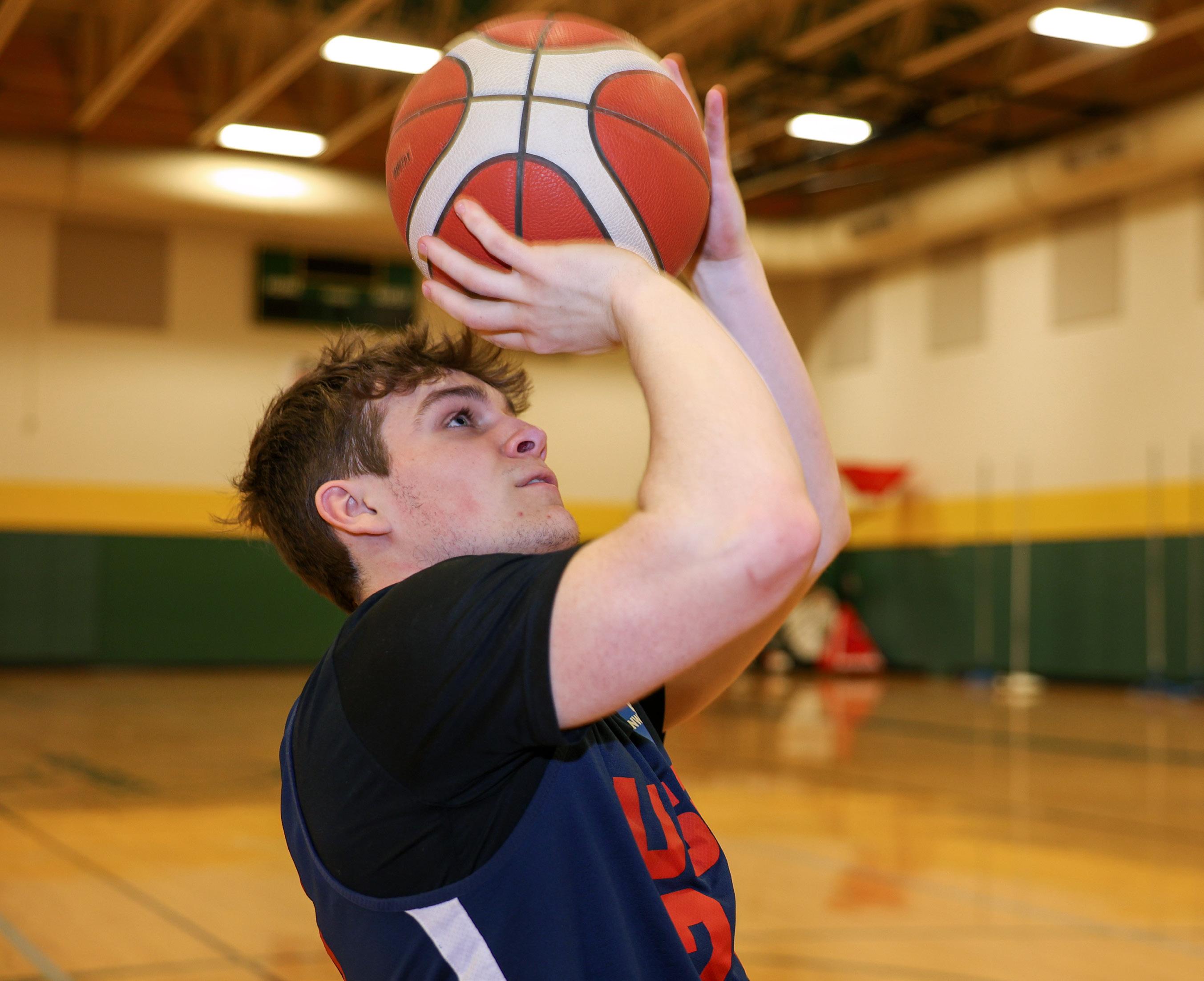
A coach recommended that Davis try out for the U.S. Men’s U23 wheelchair basketball team. He has surprised those around him with this accomplishment at only 18 years old.
reached out to the Taylors and suggested that Davis try out for the U.S. Men’s Under-23 wheelchair basketball team. The tryout consisted of three different cuts. Davis made it through the first round, then the second and then the third to be named to the final 12-person team. Davis, who was 17 years old at the time, remained through both cuts.
“We really thought it was a long shot for Davis,” Trish says. “We thought it would be a good experience for him to play with the best young players in the country. But we honestly thought, because of how young he was, that he might not make the final team.” As he had done for three straight years following his accident, he surprised those around him and made
the final roster. Davis will represent the U.S. April 2-6 at the World Qualifiers in Bogotá, Colombia. If the team finishes on the podium, it will move on to the World Championships in June in Brazil.
Trish believed in him. Garrett believed in him. Luke Neal believed in him. His friends believed in him. Davis has a big village: one that shows up, that supports him without question.
And in a way, Davis is showing up for them too — he doesn’t just live for himself. “You’re living for God and the people around you,” Davis says. “When you can transform your mindset from thinking about yourself all the time to thinking about God and the millions of people around you, it definitely helps.”



Alexis Candia brings her lifelong love of baking to Ozark Mountain Biscuit Co.
BY EMMA ZAWACKI
Alexis Candia was born in Fort Lauderdale, Florida, but in middle school, her family moved to a remote farm in Alabama. In exchange for taking care of the land, her family resided in a hunting lodge rent-free.
This left Candia with few activities beyond collecting recipe cards from Walmart and watching cooking shows on TV. She didn’t just watch the shows, though — she learned how to cook from them. It was Iron Chef America that convinced her cooking might be a fun career. “They just made cooking look really cool,” she says.
One upside of rural life was easy ac-
cess to quality ingredients — the building blocks of good cooking.
“We were working with fresh, homegrown produce like farm-fresh eggs (and) meat,” Candia says.
Today, Candia continues to work with fresh ingredients in her role as a pastry chef at Ozark Mountain Biscuit Co., located in The Arcade District.
Former kitchen manager Kevin Grant has witnessed Candia’s growth and devotion to seasonal ingredients firsthand.
“She likes to make sure that our dessert is matching the season,” Grant says.
Alexis Candia previously worked at 44 Stone for five years, where she started making dessert specials after learning from the pastry chefs there.
“I’m a big fan of that part.”
Candia’s craft is entirely self-taught. She skipped culinary school to avoid going into debt and instead teaches herself through repetition and YouTube tutorials. She likes to experiment and doesn’t follow recipes to a tee.
“I watch a lot of YouTube series, specifically Bon Appétit with Claire Saffitz,” Candia says. “She made her own version of Twinkies, and she built the recipe from scratch to make a better version of what they did. That’s kind of what I do.”
Like a sponge, Candia soaks up every tip and trick that she can from the online content she consumes. You’ll see

Alexis Candia loves incorporating her Southern upbringing and Hispanic heritage in her desserts. But she’s not afraid to stick to the classics as well — like this chocolate lava cake.
the results in Ozark Mountain’ Biscuit Co.’s dessert menu.
Currently, Candia is serving a s’mores pie, a White Russian tres leches cake and a flaky pastry fruit turnover. In the past, she’s designed desserts like a lightly-spiced honey cake and a Walnut Grove cheesecake made with goat cheese and black walnut beer syrup.
Southern comfort, Hispanic tradition
Since donning the apron at Ozark Mountain Biscuit Co. in 2023, Candia often comes back to her favorite kind of dessert: tarts.
“I just think a tart is simply elegant,” Candia says. “You have a nice fluted crust that looks fancy. The limit is your imagination of what you can put in them.”
Candia often combines her Southern cooking style with her Hispanic heritage, blending recipes from her parents and grandparents with flavor profiles from where she grew up.
One example is biscuits and chorizo gravy, which frequents her home cooking menu more than the restaurant’s. But
her Hispanic influence bursts through in menu items like the White Russian tres leches cake. It’s tradition with a twist.
From line cook to creative force
Candia says she has always liked the creative side of baking and will tweak recipes even after they’re on the menu. For example, she is experimenting with adding smoke to the s’mores pie to dazzle the table when the dessert is presented.
Before Ozark Mountain Biscuit Co.,
Candia worked at 44 Stone, a now-closed gastropub, where former bar manager Matt Siebert saw her transition from a line cook to a dessert innovator.
“It takes a special kind of person to do what she does,” Siebert says. “Watching her growth — from where she started to where she is now — feels like a proud dad moment.”
Candia’s journey is still evolving, but her dedication to crafting thoughtful, inventive desserts continues to shine. As she pushes boundaries in baking, one thing is certain: Columbia’s dessert-lovers are in for a treat.




From “grief grillers” to gumbo, this family-run food truck brings a taste of Louisiana to Columbia.
BY ASHLEY FLEWELLEN
Whether it’s the vibrant red banner sporting a silhouette with a mohawk or the rich aroma of freshly cooked Cajun cuisine, Das Byrd’s Nest demands attention.
Das Byrd’s Nest is more than a place to eat. It is a traveling reminder of Louisiana — the birthplace of Cajun cuisine — and the home state of Jodi Prudhomme and Cody “Byrd” Jardneaux food truck co-owners. They incorporate Southern influences into a menu of stuffed burgers, loaded hot dogs and “grief grillers,” which are loaded grilled cheese sandwiches that make you go, “Oh, good grief,” Prudhomme says.
The entrepreneur-couple moved to central Missouri after hurricanes Delta and Laura devastated their home. Prudhomme says Delta damaged her house, and a few weeks later, Laura finished the job. Byrd served as head of the kitchen at Panorama Music House, a live music venue, before both hurricanes caused the building to collapse.
“We had to evacuate,” Byrd says. “By the time we were able to get in, people had already went in there and looted.”
Together with their son, Prudhomme and Byrd decided to leave Louisiana to get away from hurricanes but remain a day’s worth of travel from family, Prudhomme says.
Columbia stood out for its high schools, which allowed the couple’s son to take both German and weightlifting classes.
With Byrd’s cooking background, they set out to make their mark on the food truck scene in mid-Missouri. Prudhomme and Byrd began working

on the Das Byrd’s Nest trailer in October 2023 and launched their business in April 2024.
To perfect their flavors, their meat is coated with three rounds of seasonings. They prepare and store ingredients at CoMo Cooks Shared Kitchen, a community kitchen utilized by many food trucks. During colder months, Das Byrd’s Nest adapts to a winter menu of red beans and rice, gumbo and jamba-
laya, aiming to keep the community warm. The food truck earned silver in the specialty foods category and bronze in the Cajun category of Columbia’s 2024 CommunityVotes awards.
Das Byrd’s Nest rarely stays in one place. Of all its stops, Byrd says the Orr Street Farm & Art Market was the most welcoming last year, even with smaller turnouts, as he has built connections with fellow vendors. Laura Vientos, a
Aside from classic hot dogs, Byrd also puts his own spin on the dish with the “Byrd dog,” loaded with chili, two types of cheese and pepperoni slices.
Follow Das Byrd’s Nest on Facebook to find out where it will be serving up Louisiana-inspired fare that week. The truck often sets up shop at the Boone County Courthouse, farmers markets and various places around Business Loop 70.
volunteer organizer for the Orr Street Farm & Art Market, often recommends Das Byrd’s Nest to other organizers. “There’s so much more flavor to what they’re offering,” Vientos says. “Other food trucks and stuff — it’s a lot more traditional.”
Within a year of opening, the truck has been sighted regularly at Midway Antique Mall, Witches and Wizards Arcade, Logboat Brewing Co., Columbia College, Battle High School and more.
Das Byrd’s Nest will continue improving. The breakfast burrito they added to the menu is now the most popular item, Byrd says. He also says he’s open to experimenting more and possibly introducing vegetarian options.
As a family business, Das Byrd’s Nest keeps its Louisiana roots close while embracing its new home in Columbia. “For Southern people, food is love,” Prudhomme says. “You feed people you care about — you feed people even when you don’t care about ’em, just because you reach people that way. We’re out here trying to show love and spread that.”

by Olivia

Nature photographers capture the beauty of wildlife while providing vital attention to waning populations.
BY ALLY SCHNIEPP
Noppadol “Nop” Paothong, a nature photographer based in Columbia, says conservation photography is more important now than ever. He uses his photography to highlight the dwindling numbers of animals and insects that might otherwise go unnoticed. Photographing nature through a conservationist lens makes the images take on an urgent quality. Many of the animals showcased in conservation photography could cease to exist.
Paothong’s appreciation for overlooked wildlife is inspiring; every creature he captures with his camera plays an important role in our ecosystem. With more animals on the endangered species list each year — and some animals becoming extinct — Paothong’s line of work is crucial for spreading awareness.
“We use photographs to tell the story because animals cannot speak for themselves,” Paothong says. “I use my images to speak for them, to talk about the urgency of conservation.”
Paothong, who discovered a love for photography when he was 8 years old, has published two photography books, one on North American grassland grouse species and the second on the greater sage-grouse. Paothong’s first book, Save the Last Dance, took over a





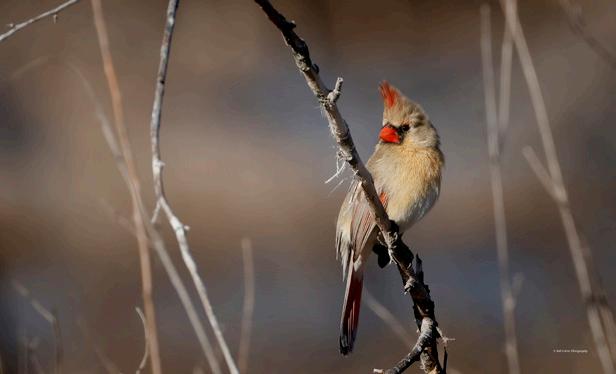
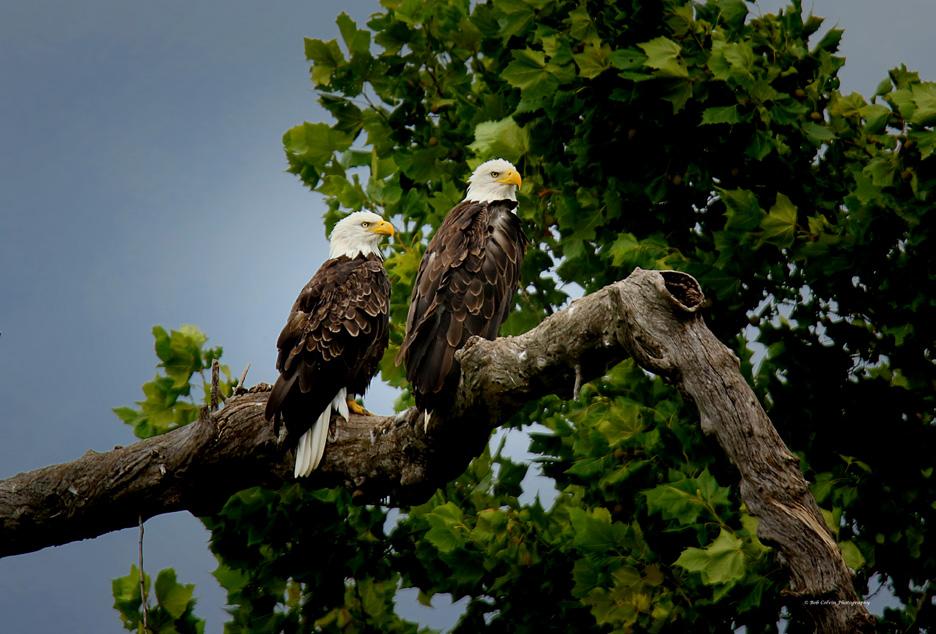

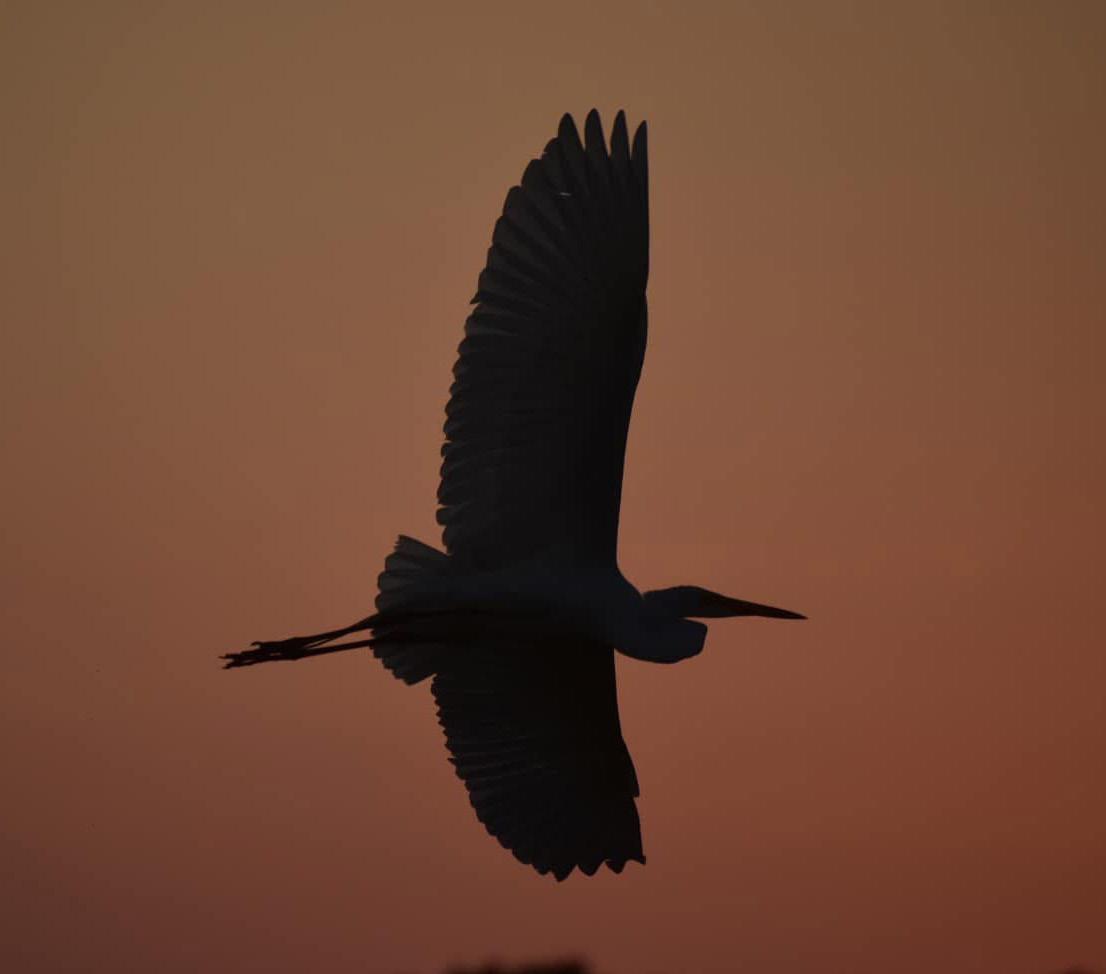

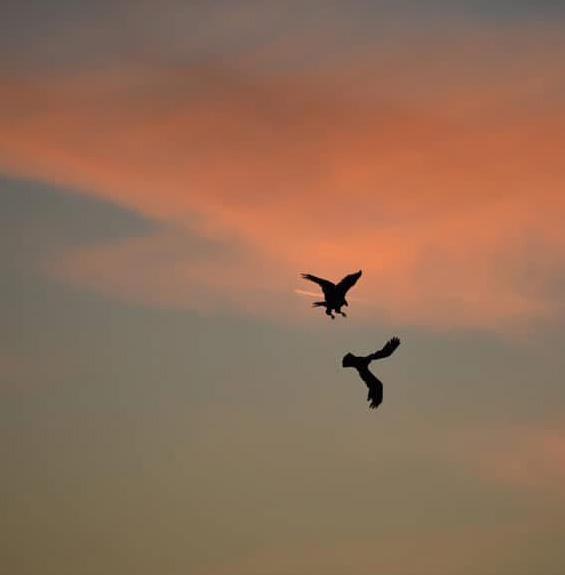


decade of work before it was published.
Grouse are plump, ground-dwelling birds with feathered legs and toes. They are typically hunted for their meat. The grouse population is endangered and has decreased over the last decade with the loss of farmland.
Paothong’s books not only bring awareness to the endangerment of grouse nationally, but also present the importance of conservation. Kathy Love, editor of Save the Last Dance, was ap-
The greater sagegrouse is native to the sagebrush areas of the West.
Nop Paothong offers this advice for aspiring nature photographers.
1. As in life, the biggest advice in nature photography is to learn from your mistakes.
2. Your care and connection with your subject will be reflected in your photos.
3. When working with wildlife, be patient and earn their trust.
4. Create a plan before you go to the site.
proached by Paothong to collaborate on the book because of their mutual appreciation for the birds. Love wrote an article about grouse for the Missouri Conservationist in the early 2000s and jumped on the opportunity to work with Paothong.
“People who wouldn’t ordinarily be interested in, say, sage-grouse, get drawn in by their beauty and how unusual they are,” Love says. “They say things like, ‘I didn’t really know very much about sagegrouse, but I saw those photographs, and I was just blown away.’ ”
Paothong’s compassion for the endangered bird manifests through his photography. He hopes to inspire audiences to become more informed on the topic.
“I want to have my photographs have some meaning,” Paothong says. “Go out and try to go beyond just the surface. Go a bit deeper.”
Local nature photographer Ellie Abernathy agrees with the sentiment. She has been pursuing photography
as a hobby for the past four years and frequently photographs at Eagle Bluffs.
“It’s important to share how beautiful the world can be and to help bring appreciation to nature and raise awareness of how beautiful the natural world is, ensuring, hopefully, that will inspire people to protect it and preserve it,” Abernathy says.
Bob Colvin says admiring wildlife from a distance honors the animals.
Colvin has 46 years of experience in photography and is an administrator of the Friends of Eagle Bluffs Facebook photography group. He has traveled around the world photographing wildlife, frequenting local places like Eagle Bluffs as well as Yellowstone National Park, which he has visited 38 times.
Every nature photography adventure he goes on results in different perspectives and photos. “You’re not supposed to intrude on any wildlife,” Colvin says. “You’re there to make a record of what you’ve seen. I want other people to enjoy what I have seen.”

Your curated guide of what to do in Columbia this month.
Laugh your heart out as Kansas City’s Andrea Caspari brings her comedy tour to The Tokyo Club with opener Andy Hamilton. Hang out at The Afterlife Lounge or play a few rounds of pinball before the show. The Tokyo Club opened in December as a spot for games, drinks and laughs. March 28, 8:30-10:30 p.m., $20, The Tokyo Club, info@thetokyoclub.net
Vanya and Sonia and Masha and Spike
Ever heard of a Chekhovian dramedy? Now is your chance to see one at Columbia Entertainment Company’s production of Vanya and Sonia and Masha and Spike by Christopher Durang. This play carries themes of romance and family, and won the 2013 Tony Award for Best Play. April 3-5 and 10-12, 7:30 p.m., April 6 and 13, 2:00 p.m., $15-$20, 1800 Nelwood Drive, 573-474-3699
The Women Opening Reception
Don’t miss the opening reception for The Women, a limited art exhibit at Sager Reeves Gallery. After its opening, The Women will be featured from 11 a.m. to 2 p.m. at Slow Art Saturday on April 5 and will remain on display at Sager Reeves until April 26. April 4, 6 p.m., Sager Reeves Gallery, free, 573-442-4831
Want to take your smartphone photography to the next level? Local professional photographer Jonathan Asher is hosting a workshop on the ins and outs of taking, editing and sharing professional-looking photographs — all from one device. April 6, 2-3:30 p.m., Columbia Public Library, free, 15+, 573443-3161
Romero
Catch the story of El Salvadoran Archbishop Óscar Romero in a new

puppet-filled play. Romero’s journey to sainthood is told through song, papiermâché and projection in this MU production, which focuses on his legacy of social justice and liberation. April 23-26, 7:30 p.m.; April 27, 2 p.m., Rhynsburger Theatre, $22, 573-882-2021
Looking for a leafy addition to your yard? Columbia Farmers Market will celebrate Arbor Day with a free tree giveaway. Bare root seedlings will be given out from 8 a.m. to noon or until all trees have found a home. April 6, 8 a.m. to noon, Columbia Farmers Market, free, 573-823-6889
Said
Let your voice be heard at the third annual That’s What She Said Columbia show, where local women share experiences and build community. This year, the event will be partnering with local nonprofit Love Columbia as its charity partner. Speakers include Ava and Greta Gunderson, Shaunda Hamilton, Linda Helmick and Rochara Knight. April 12, 7 p.m., Missouri Theatre, $40, 785-220-4556
Greenwood Preservation is a film by the Missouri Coalition for the Environment that highlights the story of Raphael and Shelly Morris and their efforts to preserve a historic Black cemetery in St. Louis. See this film at the 24th annual national tour of the Wild & Scenic Film Festival. March 30, 1:30 p.m., The Blue Note, $20-$45, info@ moenvironment.org
If you’re looking for spring break plans, try cuddling up with cats and hot tea at Bertha’s Beans. All cats at the café are adoptable through Columbia Second Chance. Will you find your forever friend? Don’t forget to show up in your silliest outfit for the dress-up contest. March 28, 2 p.m., Bertha’s Beans Cat Café, $18, 573554-5407
Pasta La Fata’s decadent Italian Dinner Series is hitting the Alps. Aged mountain cheeses and hearty polenta will inspire this five-course dinner. For an extra $25, you can choose from a variety of regional Italian wines to be added to each course. April 26, 5:30 p.m. and 8:15 p.m.; April 27, 5 p.m. and 7:45 p.m., Pasta La Fata, $100, 573-554-5466
Gimme Gimme Disco
Calling all dancing queens! It’s time to break out your sequins, platform shoes and best moves, because Gimme Gimme Disco is here. This DJ-based dance party will
#BeUnderstood


play popular ABBA tunes, plus disco hits from The Bee Gees, Donna Summer and Cher. March 29, 9 p.m., 18+, Rose Music Hall, $15-$20, 573-874-1944
Step into a world of magic, love and destiny with the State Ballet Theatre of Ukraine’s rendition of Swan Lake. This full-scale production features Tchaikovsky’s legendary score and exquisite artistic direction by Andrei Litvinov, who brings Marius Petipa and Lev Ivanov’s masterful choreography to life. April 1, 7:30 p.m., Jesse Auditorium, tickets start at $46.78, 573-882-3781
Break out the digital cameras, dust off your lowrise jeans and get ready to experience a nostalgic blast from the past! Take a journey back to the early aughts with tunes from Britney Spears, Eminem and more. April 5, 9 p.m., 18+, The Blue Note, $15-$35, 573-874-1944
Neon
Catch Neon Trees at The Blue Note during the band’s Sink Your Teeth tour. Known for hits like “Animal” and “Everybody Talks,” Neon Trees will bring its signature blend of pop and indie rock to Columbia. April 9, 8 p.m., The Blue Note, $25-$45, 573-874-1944
Listen to a selection of choral and orchestral works debuting at the 2024 Missouri Composers Project concert. The four featured pieces were chosen through a competition, and each work is an original composition by artists in the state. April 13, 7:30 p.m., Broadway Christian Church, free, 573-882-2604
Volunteer with Cleanup Columbia and take to the city’s streets, streams, trails and parks to pick up as much litter as possible. Gloves and other safety gear will be provided in advance, and a postcleanup lunch will be offered at noon at City Hall. April 12, assigned litter pickup location, free, 573874-7499
Hop by Logboat Brewing Company for Century 21 Community’s Eggstravaganza. Kids can hunt for eggs, make crafts and have their photo taken with the Easter Bunny. Plus, there will be local food trucks for the whole family. April 19, 12-2 p.m., Logboat Brewery, free, 573-777-5555

ARCHIVE PHOTOGRAPHY BY BAILEY STOVER
Waker Wilson plays in Goose Creek while his brother, Asa, watches the Earth Day celebration in 2023 at Peace Park. “They like to play outside,” their mother, Emily McWilliams, says. “They spend most of their days outside, like at their play school. Just getting to know the environment and mostly being barefoot to feel the earth beneath them and feel the different sensations and temperature — I think it helps with their imagination.” This year’s Earth Day Celebration will return to Peace Park on April 27 from noon to 7 p.m. with live music, vendors and activities for all ages.

“WEALWAYSSWING”®JAZZ
CELEBRATES
April 1 – 30, 2025
•CONCERTS • ARTISTS IN RESIDENCE
•LIMITED EDITION SIGNED POSTER, EXHIBIT & SALE •COMMUNITY-WIDE EVENTS

JAM KICKOFF! • TUESDAY, APRIL 1 | 5:30 P.M.
Top Ten Wines
WITH GREG AKER-ALEX FRANK DUO
MONDAY, APRIL 7 | 6 P.M.
Rock Bridge High School “CPSJAZZNIGHT!”
WITH TROMBONIST STAN BOCK, ARTIST IN RESIDENCE



TICKETS
573/449-3009 • 21 N TENTH ST M-F | 10 am-5:30 pm WeAlwaysSwing.org
Purchase The 4-Ticket Sampler & Save!
SATURDAY, APRIL 12 | 3 P.M. - 6 P.M.
Opening Reception • Signed Poster & Photo Exhibit THREEDECADESOFJAZZSERIESHISTORYVIEWEDTHROUGH ARTISTSIGNEDPOSTERS&PHOTOGRAPHY
Boone County History & Culture Museum
All proceeds from Exhibit Sales Support Jazz Series & Montminy Gallery Exhibit runs through May 3.
INTERNATIONAL JAZZ DAY CELEBRATION



A BOBBY WATSON RETROSPECTIVE PERFORMED BY COLUMBIA JAZZ ORCHESTRA
Conducted,Arranged &Featuring BOBBY WATSON

WEDNESDAY, APRIL 30, 2025 | 7 P.M. Missouri Theatre










